Borrow a telescope, astrophotography rig, mount, or accessory kit for up to three months.
A benefit of SDAA Full Contributing Membership is access to SDAA loaner equipment. The SDAA maintains a comprehensive fleet of telescopes, mounts, eyepieces, and other accessories that Full Contributing Members are eligible to borrow in three-month stretches.
If you are interested in borrowing some equipment, you can e-mail the SDAA Loaner Equipment Coordinator. You can also review the table at the bottom of the page showing current availability.
Borrowing equipment requires that members follow these steps (see additional details in the Loaner Scope Procedures).
- Contact the SDAA Loaner Equipment Coordinator to verify eligibility and equipment availability. If you are not sure what equipment is right for you, the Coordinator will help you decide.
- Meet the Coordinator at the SDAA Miramar storage facility. The Coordinator will train you in operation of the loaner equipment.
- Members are encouraged to take loaner equipment to Tierra Del Sol to use it under dark skies. Loans are for three months.
- Plan to meet the Coordinator at the SDAA Miramar storage facility when your equipment is due to be returned. The Coordinator will inspect the equipment for any damage and check the equipment back into inventory.
Visual Newtonian Telescopes
The telescopes in this section are meant exclusively for visual use, not for astrophotography. Most use a Dobsonian style mount. The Dobsonian Telescope is a Newtonian reflecting telescope (mirror in the back, eyepiece in the front) mounted on a simple up-down-left-right mount that you move by hand. These telescopes are hugely popular for beginners all the way to advanced amateur astronomers as they prioritize high quality and large aperture optics over complex and fussy electronics and motorized mounts.
The SDAA has numerous visual telescopes available, from compact table-top models that can be carried in a backpack, to popular 8, 10, and 12 inch models. Larger telescopes deliver brighter and higher resolution views, but are heavier and bulkier to move around.
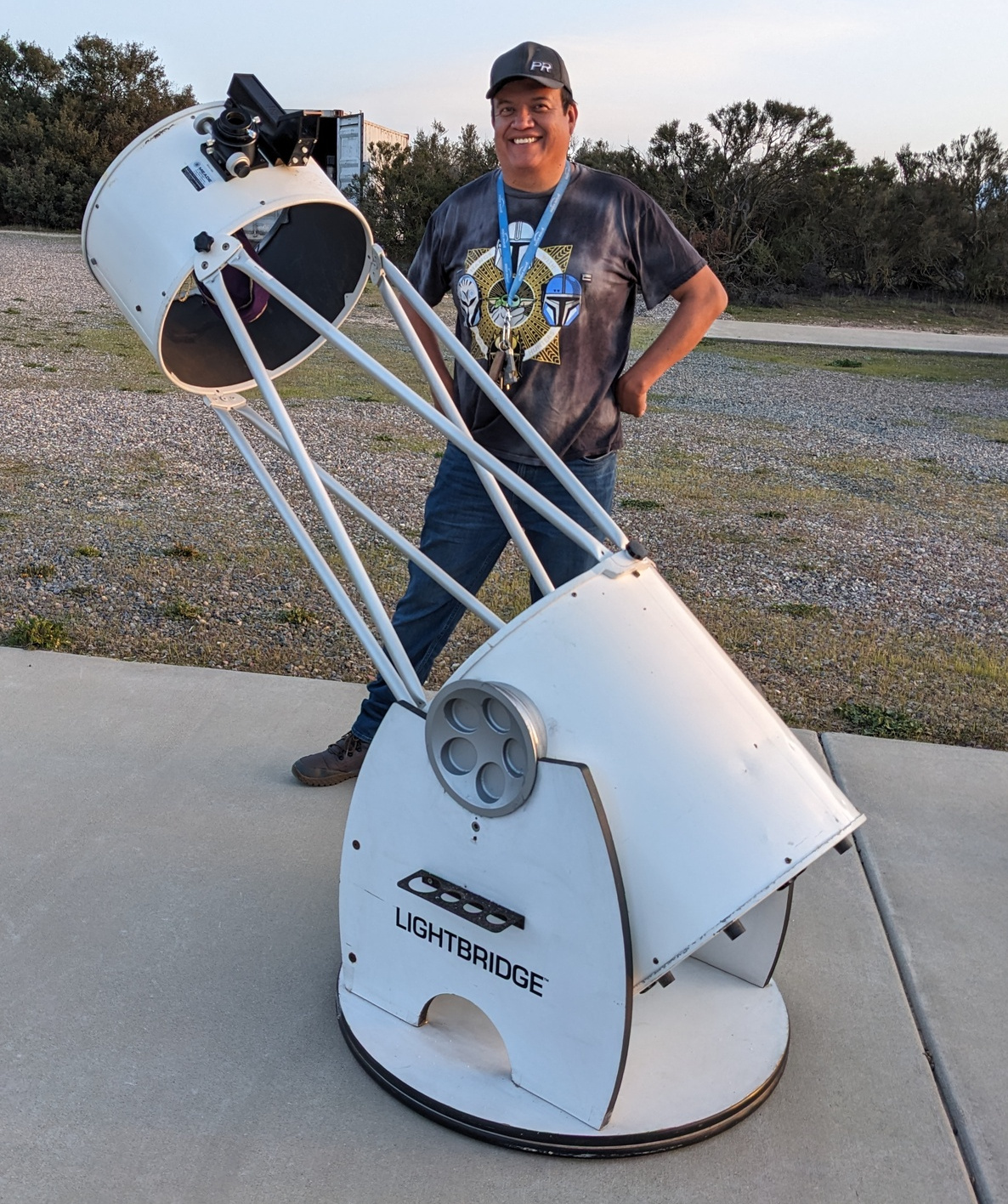 | SDAA-035 – 16″ manual Meade Lightbridge 16″ Dobsonian The largest telescope in the SDAA loaner fleet, this 16″ f/4.5 monster collects over 5x the light of an 8″ scope! Observe faint and obscure NGC and Arp galaxies, and peer deep into tiny planetary nebulae with this scope. Note that this scope is for advanced users who are already experienced assembling and using a truss-tube dobsonian. The telescope must be disassembled for transport, and even when disassembled is too large to fit in a compact car. You will need an SUV or a minivan with the middle seats removed, to be able to take this scope home. Also note that when broken down, the mirror box weighs around 70 pounds, and the ground board weighs about 40 pounds. |
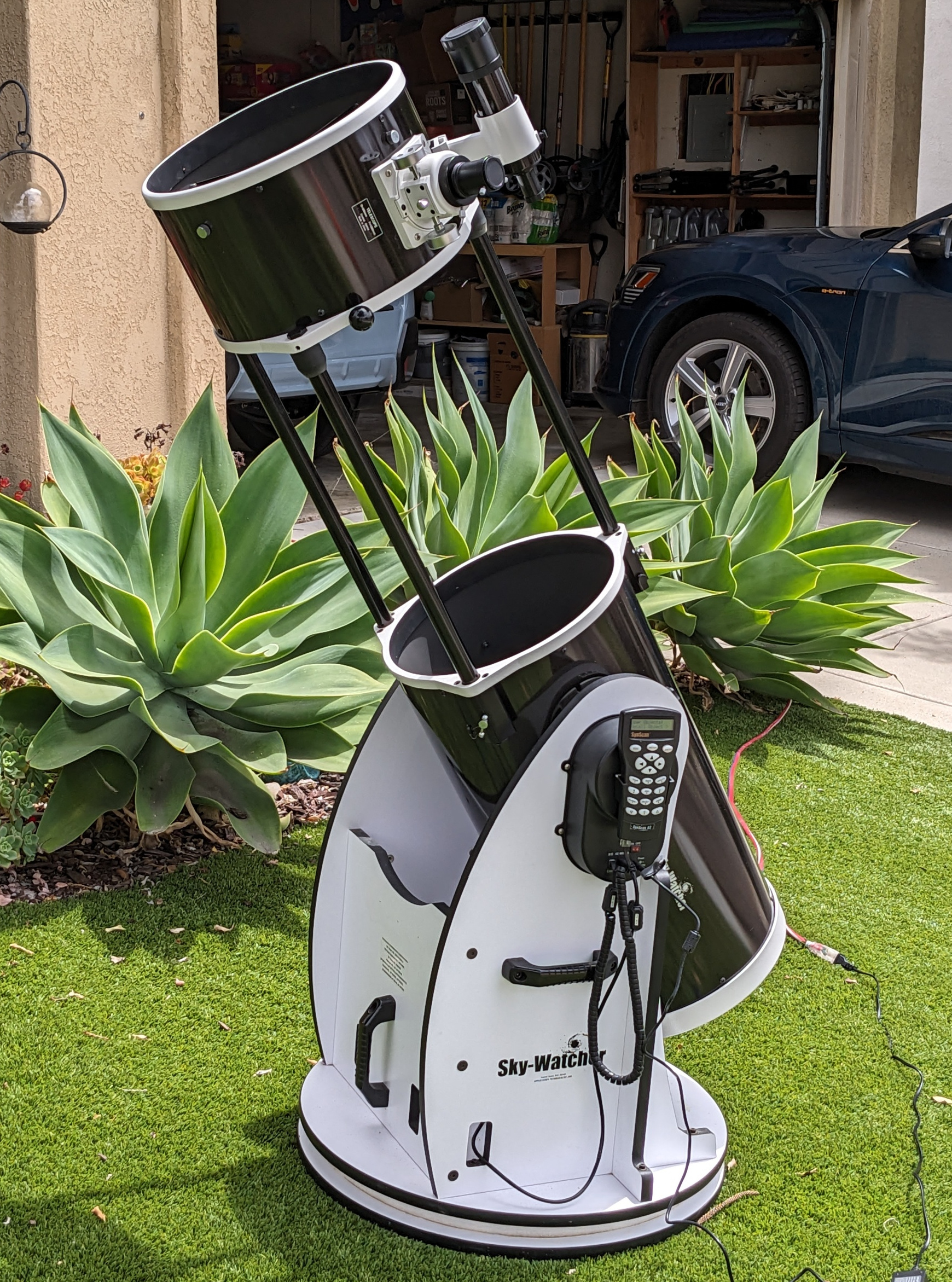 | SDAA-041 – 12″ GOTO SkyWatcher FlexTube 300P SynScan GOTO Dobsonian This 12” telescope optical tube collapses down to just a little over 36”, allowing you to transport the scope in a majority of vehicles. The large 12” f/4.9 mirror collects over twice the amount of light as an 8″ scope and has 50% higher resolution. This is a GOTO Dobosnian with drive motors on both axes. The SynScan AZ hand control allows you to select an object and the telescope will slew to it automatically and track it across the sky. Dual encoders allow the telescope to be moved manually with no need for re-alignment. |
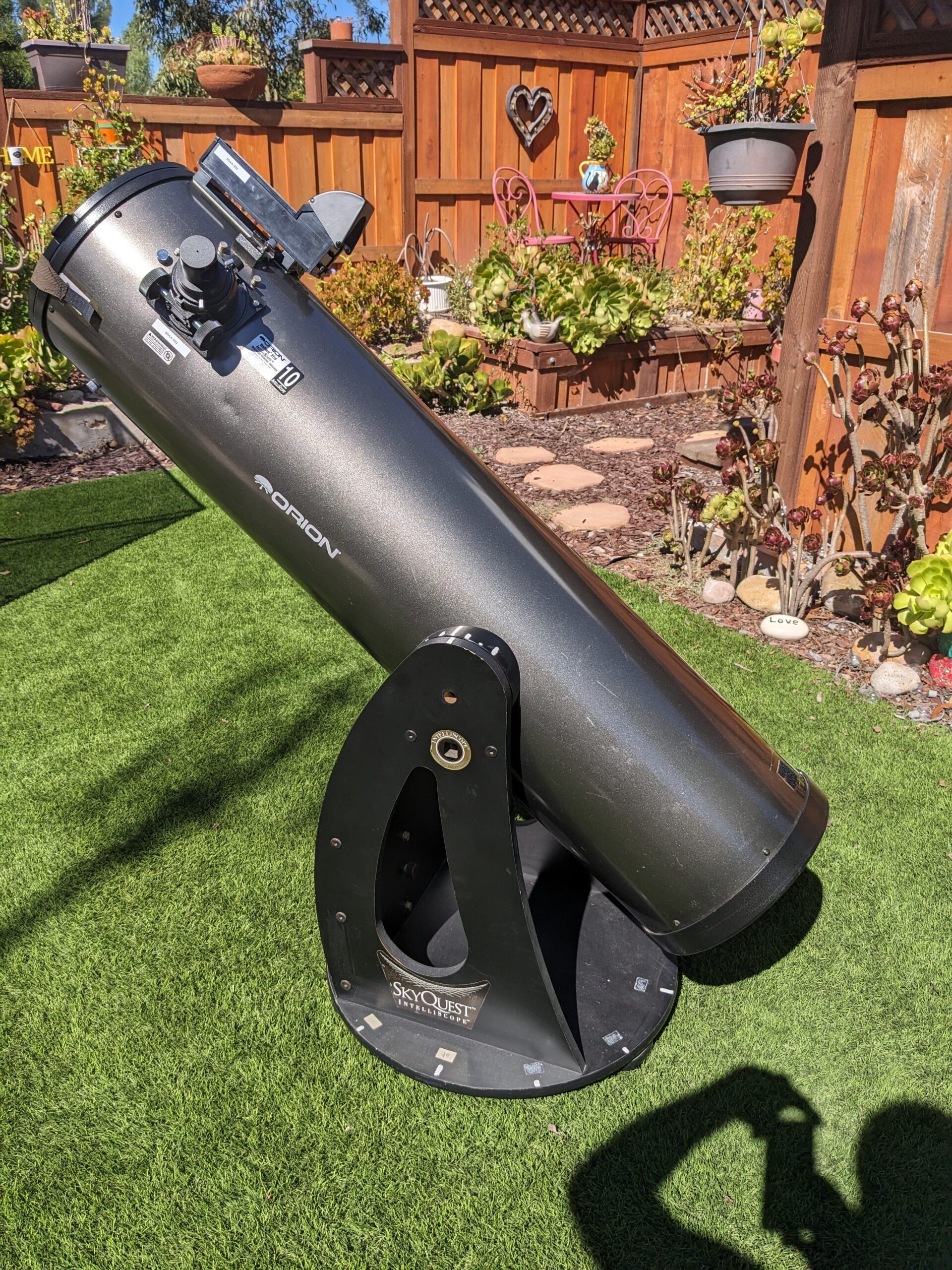 | SDAA-023, SDAA-033 – 10″ manual Enjoy one of our big 10 inch “light bucket” dobsonians under the dark skies of TDS. This telescope is a great introduction to “big scopes”, including a 2″ focuser for those big wide-angle eyepieces. 1200mm f/4.7 optics, 2″ focuser, and a Telrad. |
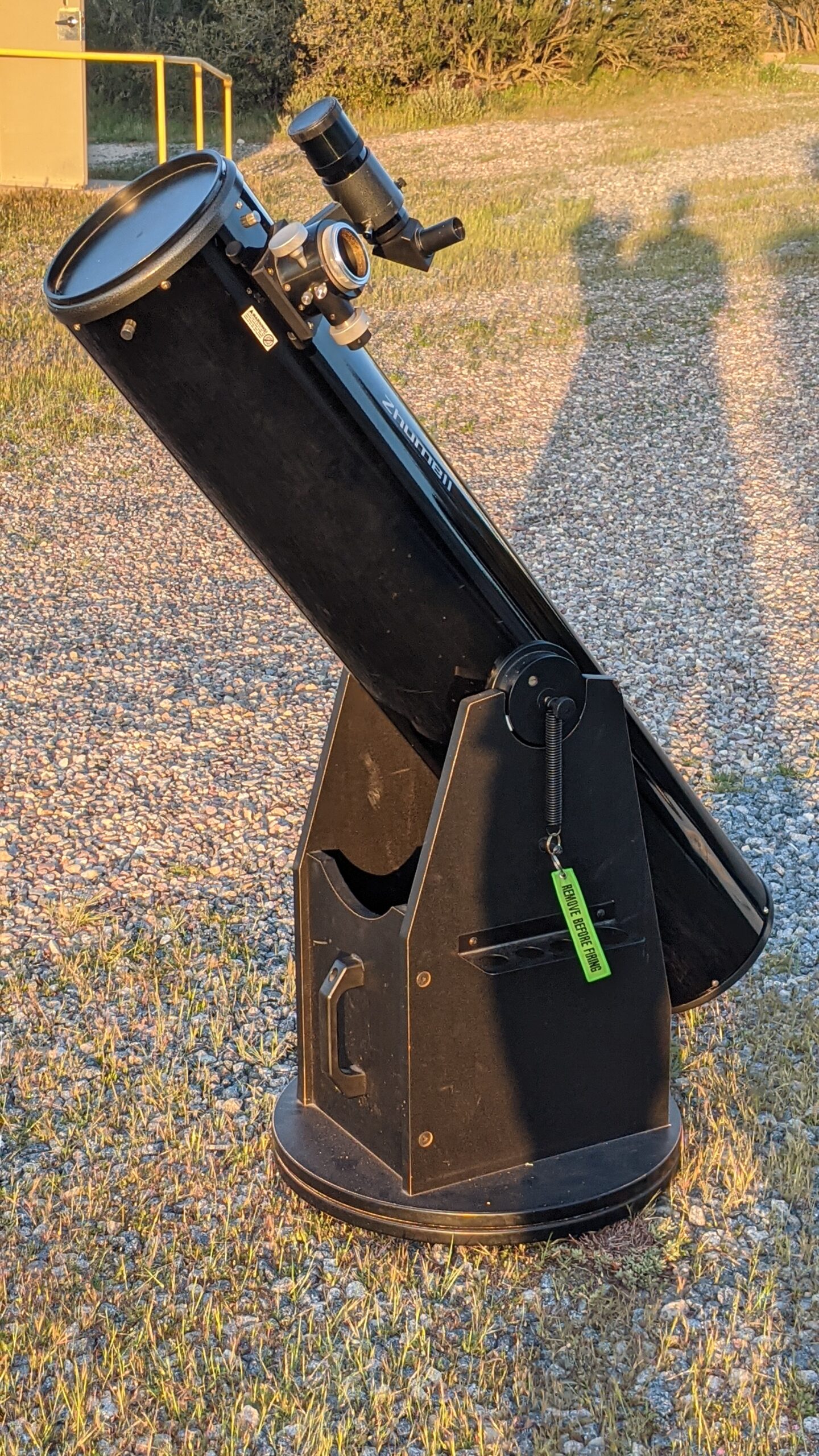 | SDAA-026, SDAA-031, SDAA-042 – 8″ manual Zhumell 8″ Dobsonian / Orion SkyQuest XT8 These 8″ telescopes have an 8” parabolic primary mirror with a f/6 focal ratio and 1200mm focal length. Includes a 2″ focuser and a Telrad. This size Dobsonian scope is small enough to pack in compact vehicles, but large enough to observe the entire Messier and Caldwell catalogs. |
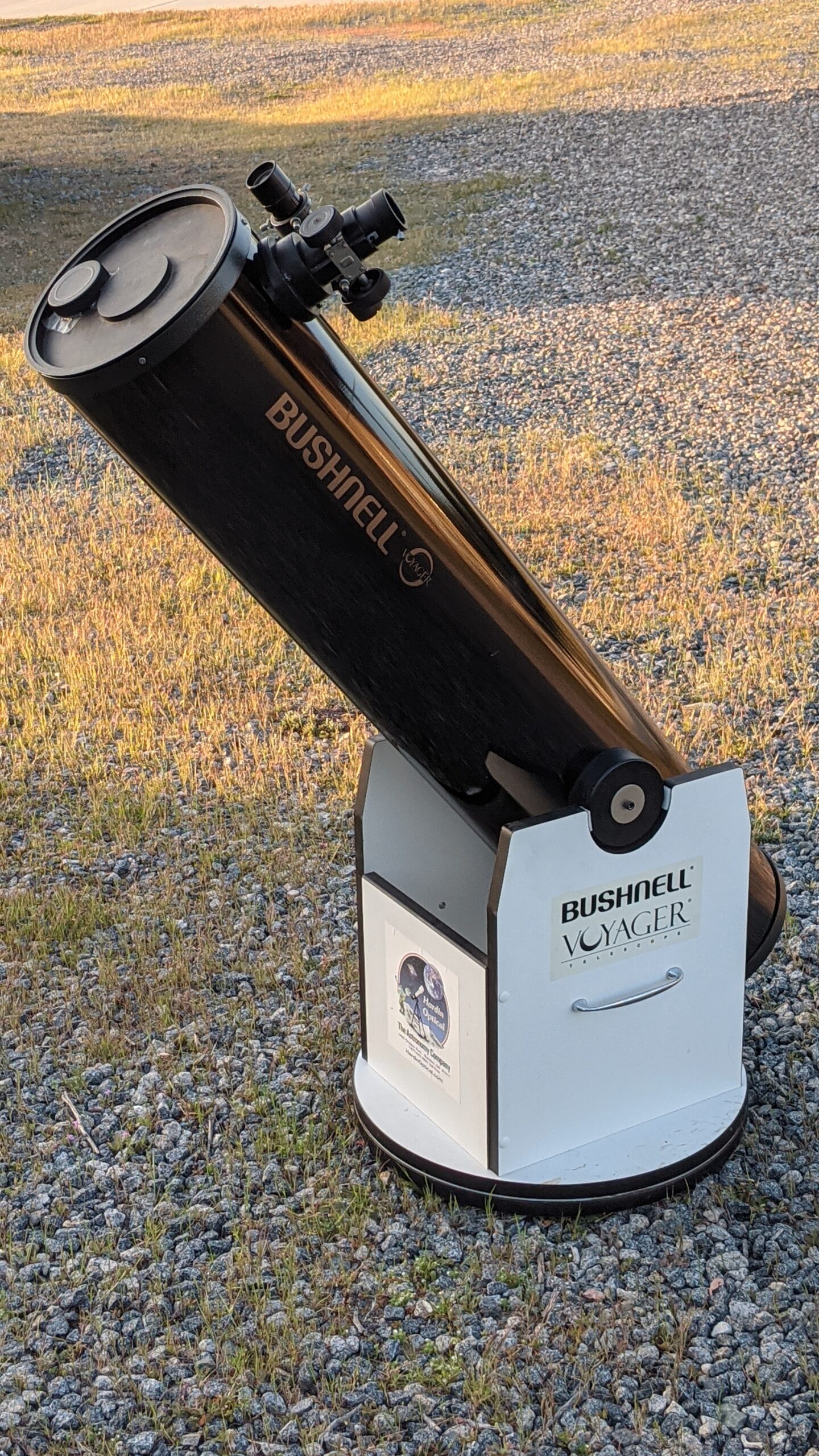 | SDAA-028 – 8″ manual Bushnell Voyager 8″ Dobsonian Easy to set up and easy to transport, the Bushnell Voyager features an 8″ parabolic mirror with a f/6 focal ratio and 1200mm focal length, with a 1.25″ focuser. This is a great scope to borrow if you have kids who want to learn to use a telescope. It is rugged and super simple to use. |
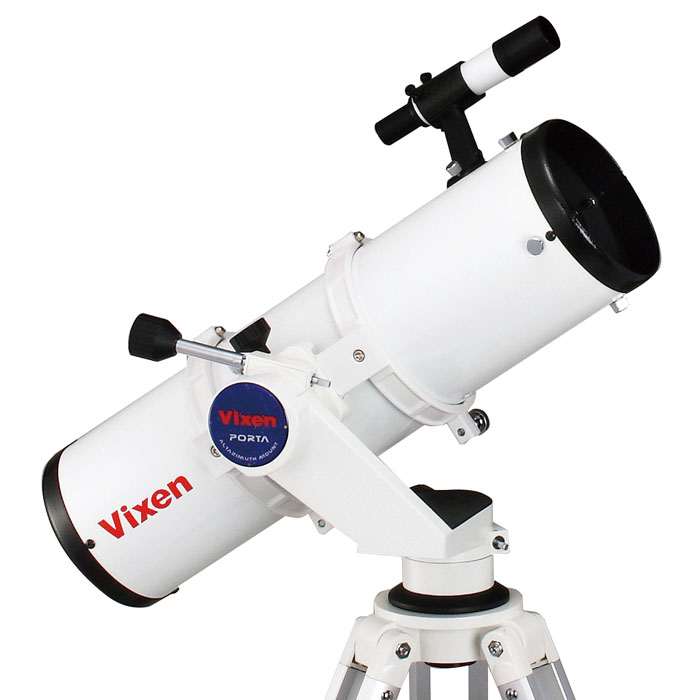 | SDAA-076 – 5″ manual Featuring excellent rigidity, stability, and portability, the popular Vixen PORTA II alt-azimuth mount is paired with with a premium Japanese 130mm f/5 Newtonian reflector. The PORTA II mount is a manual alt-az mount featuring a sturdy aluminum tripod and slow-motion control on both axes for precise pointing at any object in the sky. When broken down into separate pieces (OTA, tripod+mount, accessory box) each component weighs less than 15 pounds and are easy to stow in even the smallest vehicles. Includes the Vixen PORTA II mount, Vixen R130Sf Newtonian reflector, 20mm finder scope, and a 90 degree adapter allowing attachment of cameras or our SDAA-034 and SDAA-037 Coronado Personal Solar Telescopes in place of the R130Sf optical tube. |
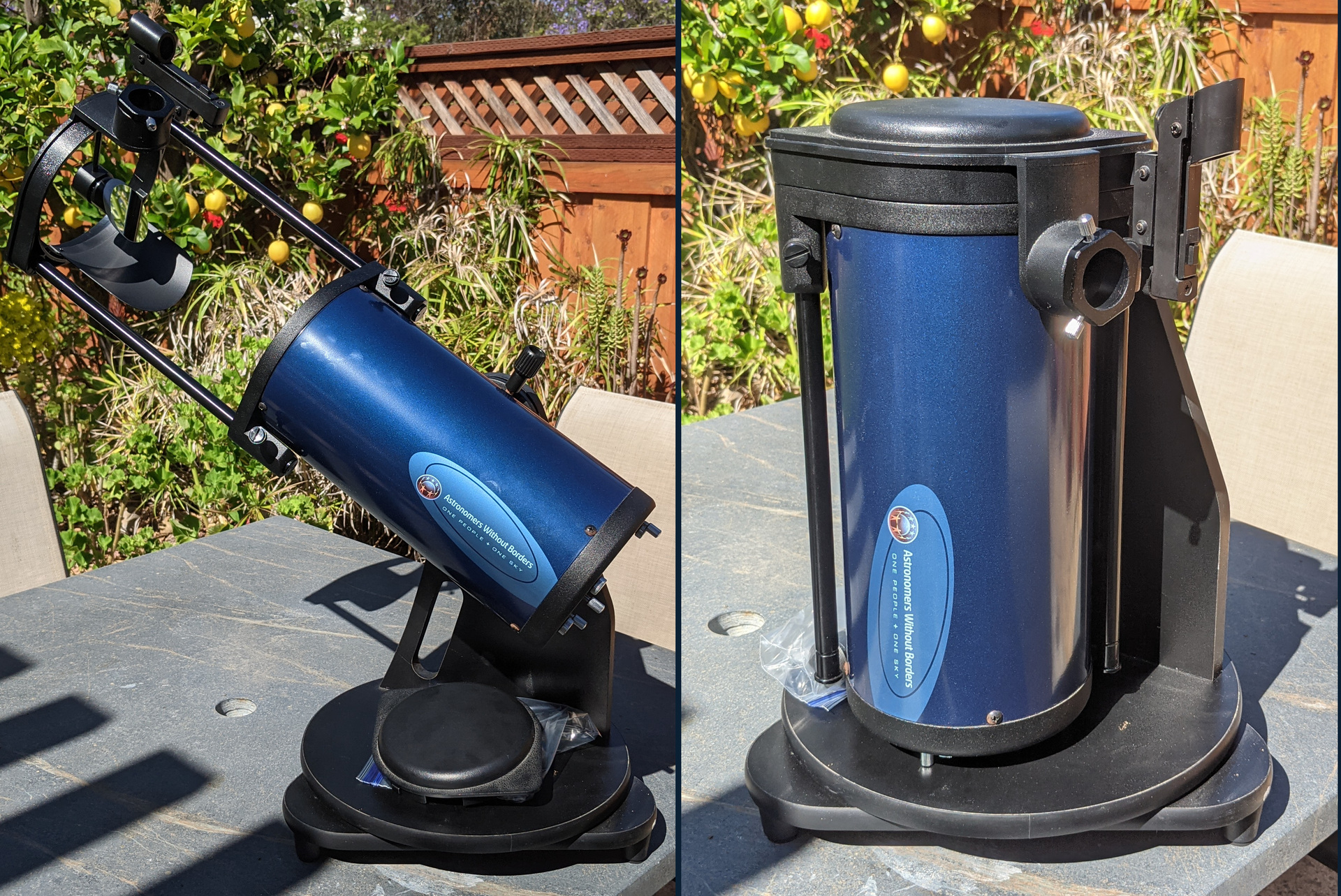 | SDAA-030 – 5″ manual The OneSky telescope from Astronomers Without Borders features a 130mm paraboloidal f/5 mirror. With a truss tube that collapses to 14.5 inches in seconds and a total weight of just 14 pounds, performance and convenience are combined in one portable package. This telescope is compact and lightweight so it’s really easy to take out and use any time there is a clear sky. Take this scope camping! The 5 inch aperture is big enough to observe hundreds of deep sky objects from dark skies. Very easy to use: great for getting kids introduced to telescopes. Features a simple helical focuser and red dot finder. |
Computerized GoTo Schmidt Cassegrain Telescopes
(Visual + Planetary/Lunar Photography)
These telescopes are Schmidt Cassegrain optical tubes riding on motorized and computerized “GoTo” mounts. Power up the mount, perform a guided alignment routine, and then all you need to do is punch in the catalog ID of the object you want to observe. The mount will automatically slew to the object and once located, track it across the sky.
These telescope systems are primarily intended for visual use, but some limited astrophotography using video captures of planets and the moon, is possible with these telescopes.
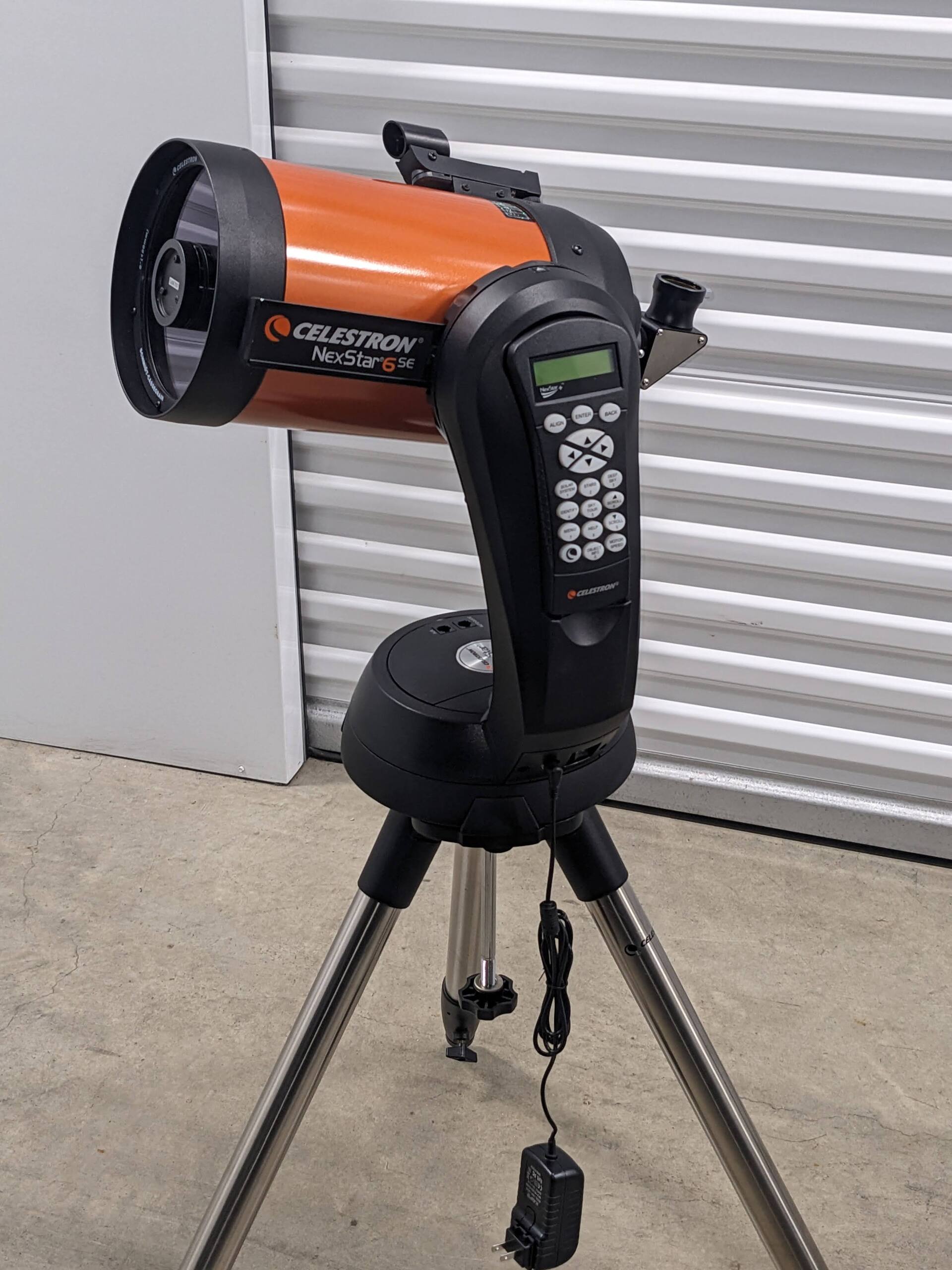 | SDAA-082 6″ Celestron 6SE The Celestron NexStar 6SE is a popular entry-level Schmidt-Cassegrain telescope, ideal for both serious beginners and experienced users looking for an optical upgrade. It features a 6-inch aperture, a motorized GoTo mount for automatic object tracking, and is known for its impressive optics, particularly for viewing lunar and deep-sky objects. The mount can run from 8x AA batteries or the included AC adapter. Includes the telescope and mount, an AC adapter, a red dot finder for performing initial alignment, and a 1.25″ visual back with Svbony mirror diagonal. This telescope does not include a camera. |
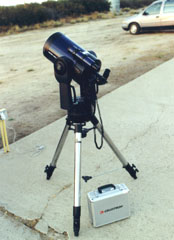 | SDAA-004, SDAA-038 8″ Meade LX-90 SCT A full computerized GOTO telescope, with Meade Autostar. This telescope, once properly aligned, will slew to virtually any object, then track it across the sky. 2000mm focal length f/10 optics with oversized primary mirror. Note that the tracking functionality is best for visual use; this scope is challenging to use for planetary astrophotography and does not include a camera. Both of these telescopes include a 2″ visual back and diagonal. |
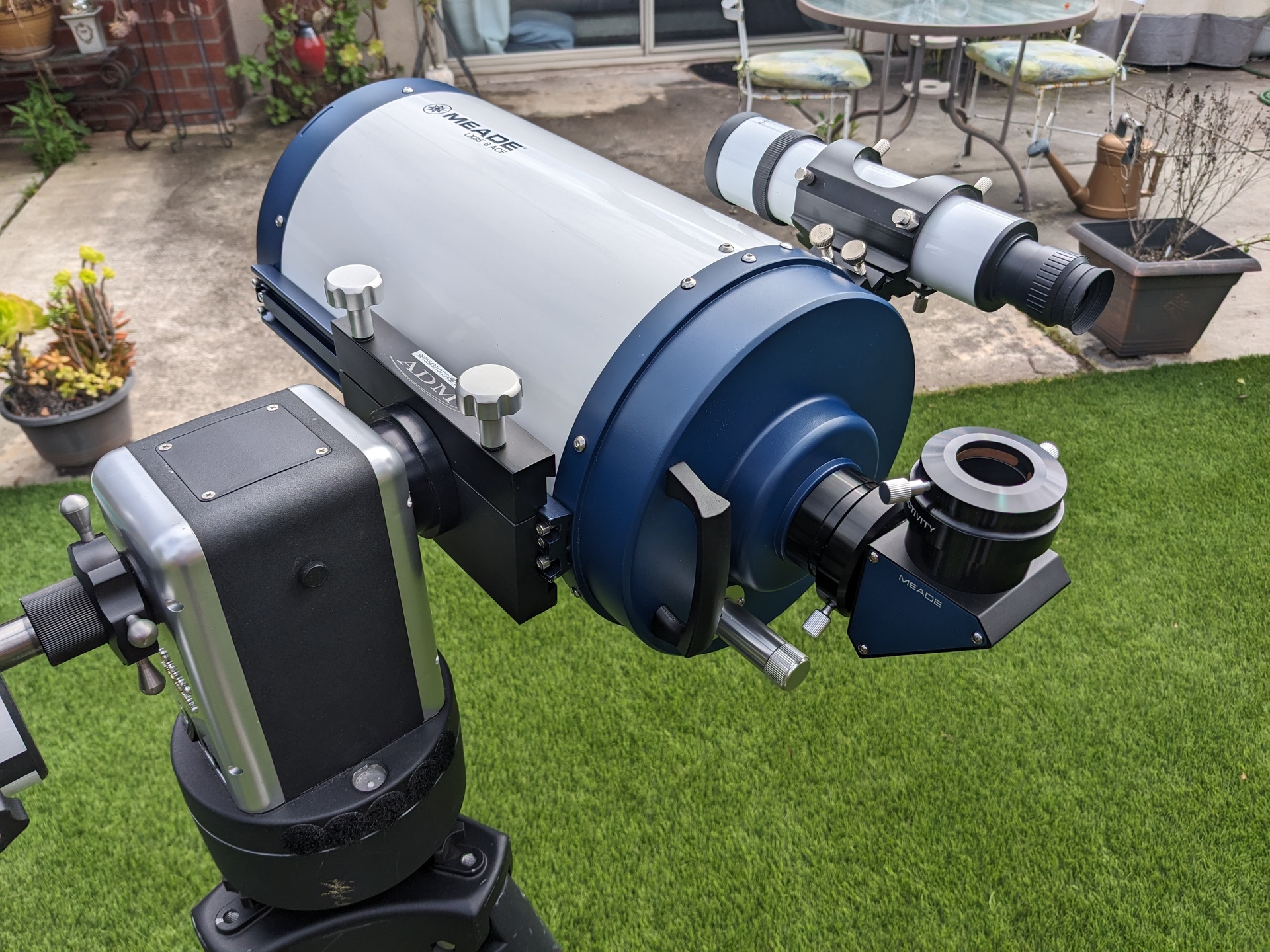 | SDAA-036 8″ Meade SCT on iOptron MiniTower Pro mount This is a fantastic platform for learning planetary photography, or for a great night of visual observing. The iOptron MiniTower Pro mount is rock solid, all metal construction, and has absolute encoders on both axes to improve pointing accuracy. Built in GPS ensures high precision GoTo every time. Includes everything you need: tripod, mount, 8″ f/10 OTA, 2″ visual back and diagonal, dew shield, and even includes a Celestron NexImage 10 solar system imaging camera. Also includes a cell phone camera holder and a second scope saddle, so you can mount your own telescope for dual-scope observing. |
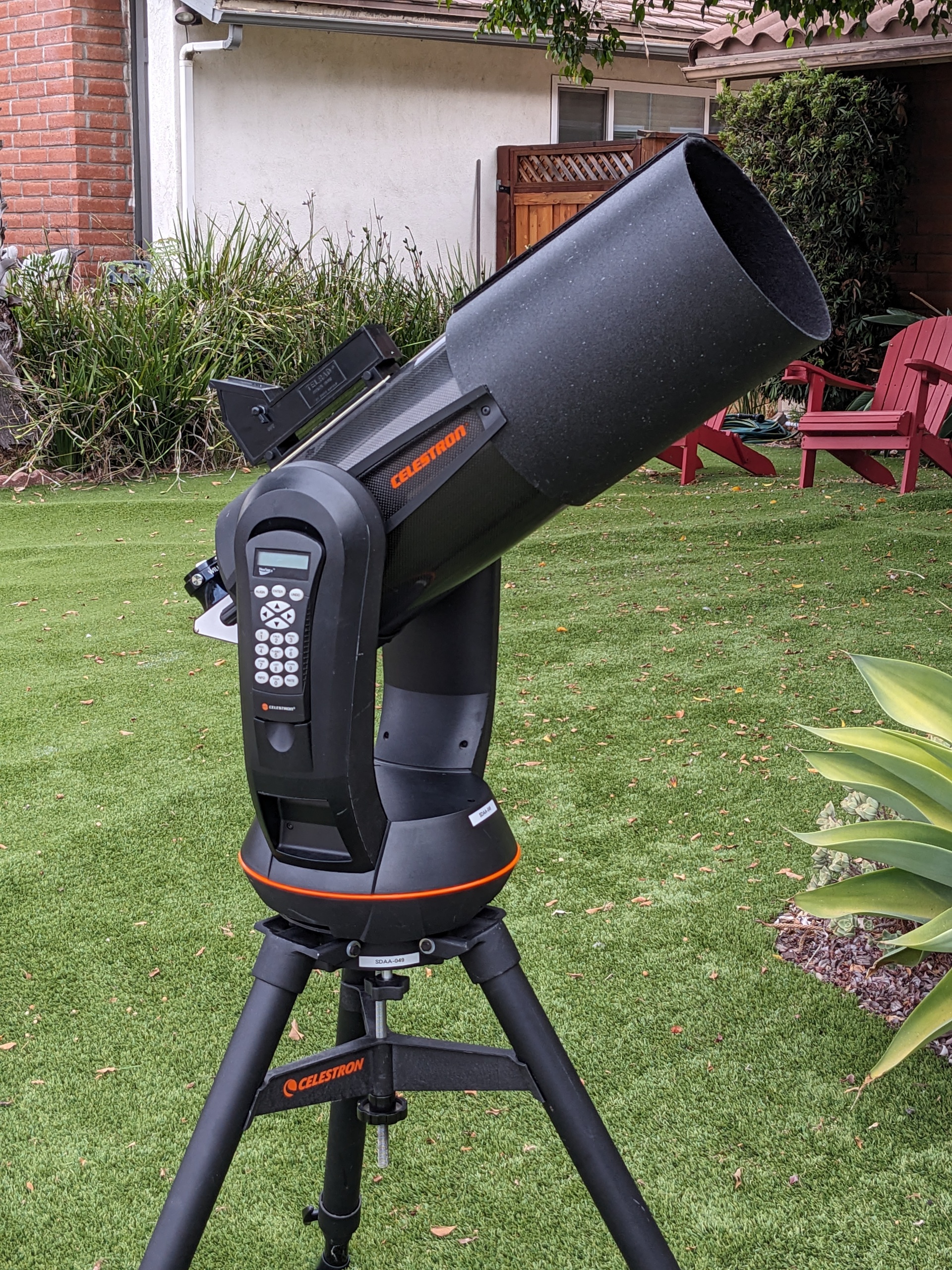 | SDAA-049 8″ Celestron NexStar CPC800 SCT The Celestron NexStar CPC800 is a powerful 8-inch telescope designed for both beginners and experienced astronomers. Its NexStar control system features advanced GOTO capabilities, allowing you to easily locate and track thousands of celestial objects with just a few button presses. The dual-fork mount provides excellent stability, even in windy conditions, ensuring clear and steady views of the night sky. Whether you’re exploring planets, galaxies, or nebulae, the CPC800 offers a reliable and enjoyable observing experience. Includes a dew shield, high quality 2″ William Optics diagonal, Telrad, and a comprehensive bound manual. Also includes a Nikon F-mount bayonet for attaching a Nikon DSLR. Note that as with all alt-az mounted telescopes, this telescope is not suitable for deep sky astrophotography. However, using the video mode of a DSLR, or a dedicated astro video camera, you can get excellent images of planets and the moon using “lucky imaging” techniques. |
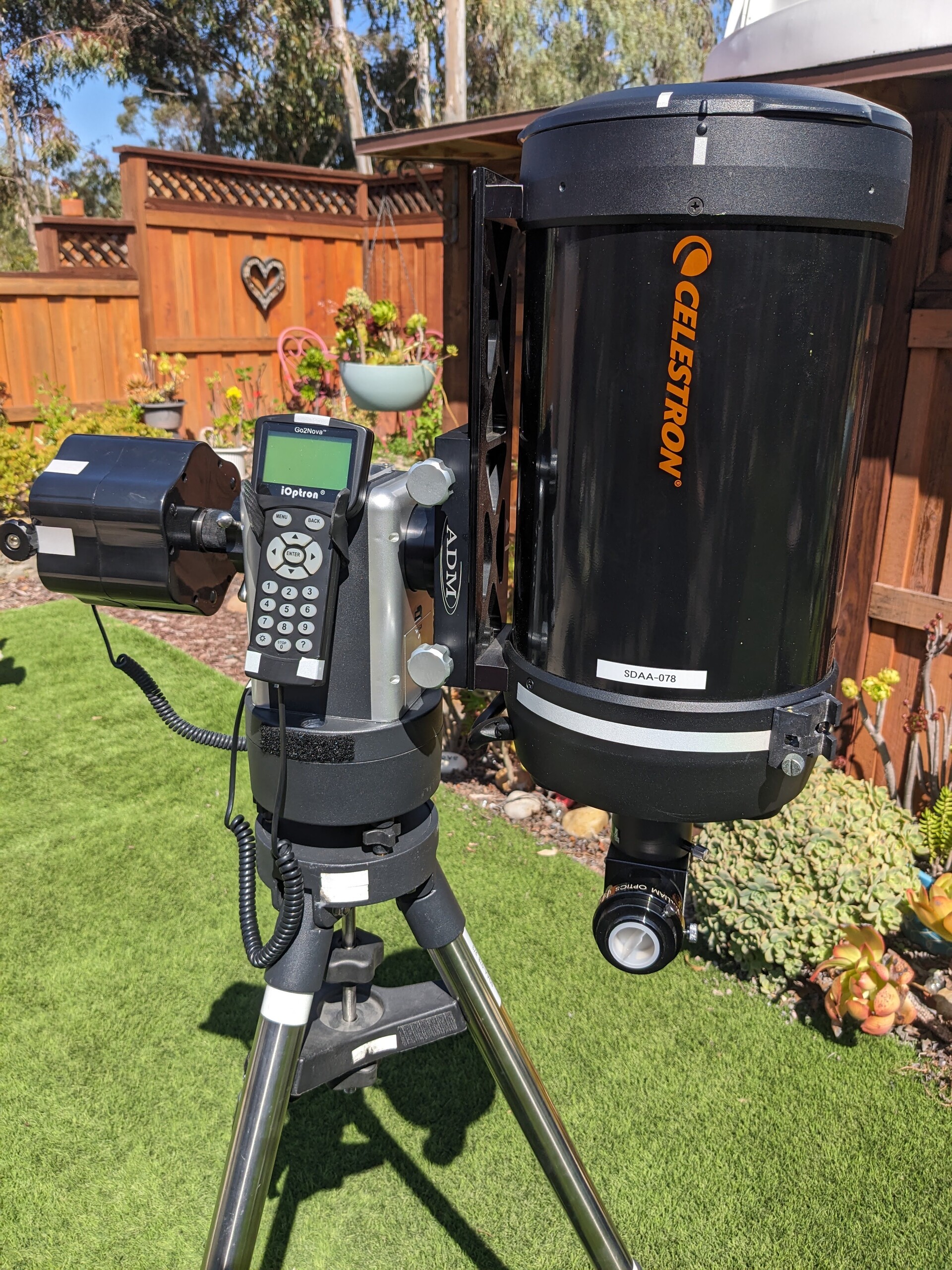 | SDAA-078 8″ Celestron C8 SCT on iOptron MiniTower II mount This compact observing system is an all-in-one solution for visual observing and planetary/lunar astrophotography. The MiniTower II mount is small but built tough with all metal internal gearing, and the iOptron Go2Nova hand control with built-in GPS makes setup and alignment easy. Includes Celestron C8 8″ f/10 OTA with a William Optics 2″ dielectric mirror diagonal, dew shield, and Bahtinov mask. The telescope rides on an iOptron MiniTower II mount with iOptron PowerWeight battery that doubles as a counterweight. Being an alt-az design, this telescope is not suitable for deep sky astrophotography. However, using the video mode of a DSLR, or a dedicated astro video camera, you can get excellent images of planets and the moon using “lucky imaging” techniques. |
Astrophotography Equipment
(Deep Sky Photography)
Astrophotography is more accessible than ever, with the cost of telescopes, mounts, cameras, and accessories constantly dropping. Capturing images, stacking, and processing them is also getting much easier as software continues to improve. But make no mistake — getting amazing images like this still requires a huge amount of knowledge, patience, and the right equipment.
The SDAA can help you get started by getting you access to otherwise pricey equipment such as sturdy motorized german equatorial mounts, fast optical tubes, cameras, and guiding equipment. You can use this equipment to determine whether astrophotography is for you. If so, you will have real-world experience to inform your purchase decisions. If not, you won’t be stuck with equipment that you now have to sell.
There is also the SDAA Astro Imagers Special Interest Group (AISIG) that meets regularly to discuss all things astrophotography. After picking up your loaner astrophotography rig, it is recommended that you engage with AISIG to help you get your bearings and make the most of your loaned equipment.
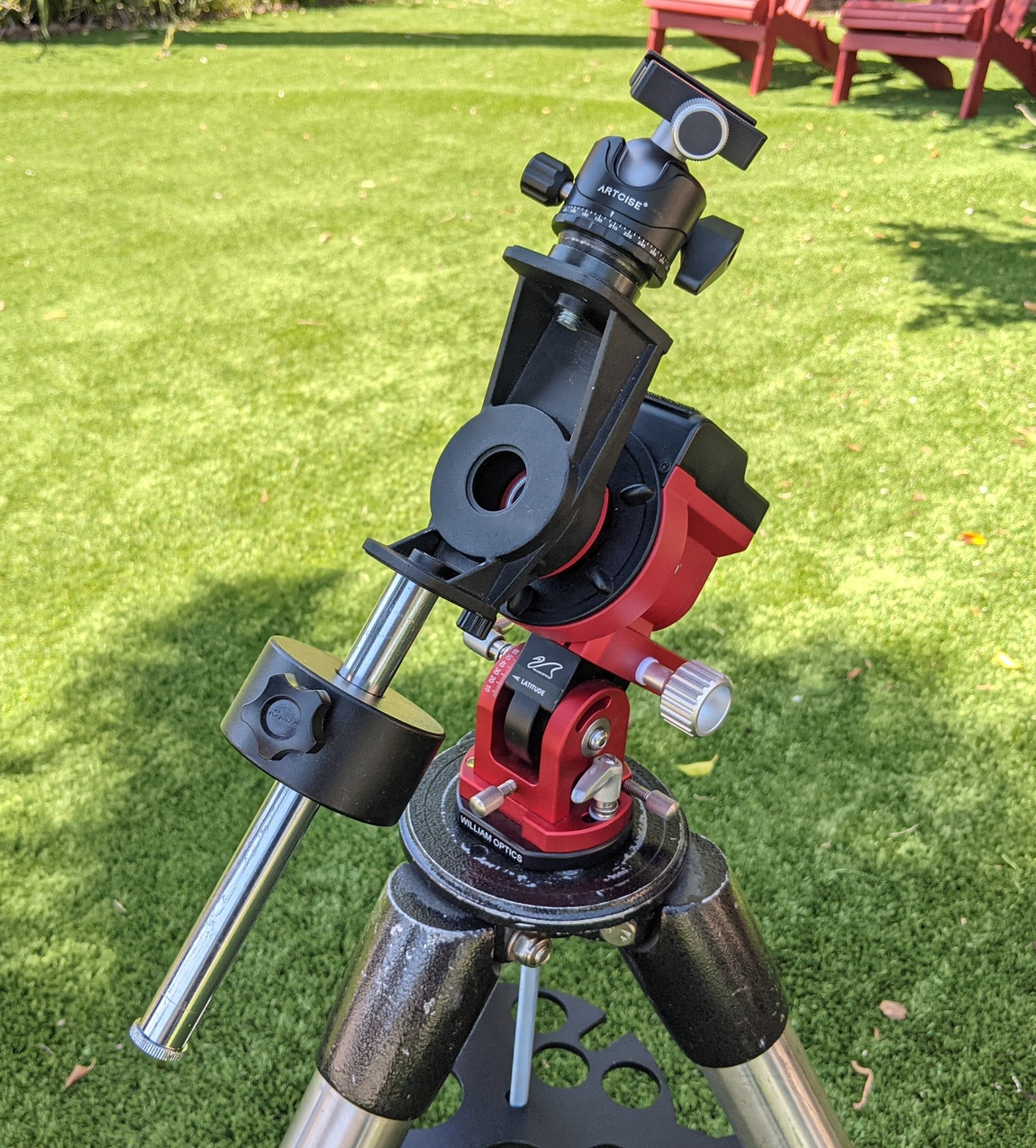 | SDAA-029: Beginner iOptron Skyguider Pro with Accessories Easy to use sky tracker that can accept your DSLR, mirrorless, point-and-shoot camera, or a small telescope. Includes everything you need (except the camera and lens) to start shooting deep sky exposures up to 10 minutes in length. Includes heavy duty 2″ steel tripod, upgraded William Optics alt-az base with polar scope, dual counterweights, heavy duty ball head mount for your camera, and a William Optics Vixen dovetail saddle for small telescopes. Also includes a Bahtinov mask to assist with focusing. The whole set packs up in two small boxes, plus the tripod: super easy to transport to dark skies. This kit will introduce new astrophotographers to the concepts of polar alignment, tracking, and how to stack and process multiple exposures to create finished images. |
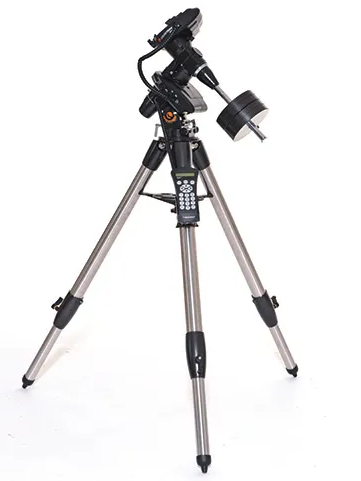 | SDAA-027: Intermediate Celestron CG-5 AS-GT German Equatorial Mount. Borrow this mount to get better acquainted with how to polar align and balance a GEM, align the pointing model, and control a telescope mount using your computer. With a good polar alignment, exposures of 2-3 minutes should be possible. The CG-5 mount is rated to carry a 30 lb. payload, but best photographic results will come from keeping the telescope+camera under 20 lb. The CG-5 manual can be found here: https://s3.amazonaws.com/celestron-site-support-files/support_files/1145296473_advancedsgt.pdf and here’s a good blog post about how to set up and use a CG-5 mount: https://themcdonalds.net/setting-up-a-celestron-as-gt-go-to-mount/ Note that this kit does NOT include a telescope or a guide scope. |
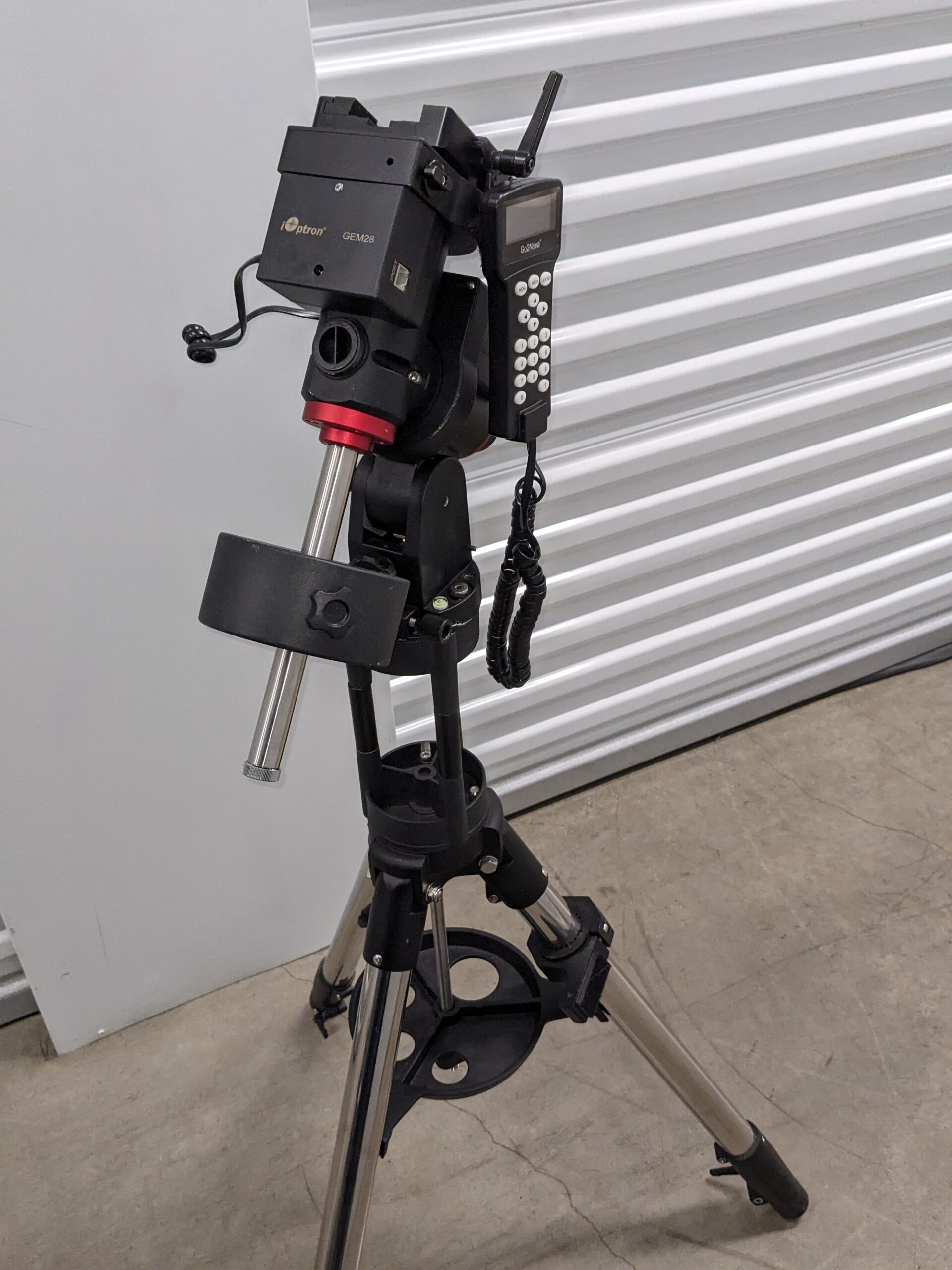 | SDAA-077: Intermediate iOptron GEM28 German Equatorial Mount. This is a high quality, precision mount with impeccable construction quality and an impressive feature set. The GEM28 is rated to carry a 28 pound instrument payload, though you should stick to 20 pounds or less for best results when imaging. Comes with the GEM28 mount head, steel tripod with pier extension, Go2Nova handset, and a custom-cut foam carrying case that stores everything in a single easy-to-transport box. You can find the manual here: https://www.ioptron.com/v/Manuals/G28_GEM28_Manual.pdf Note that this kit does NOT include a telescope or guide scope. |
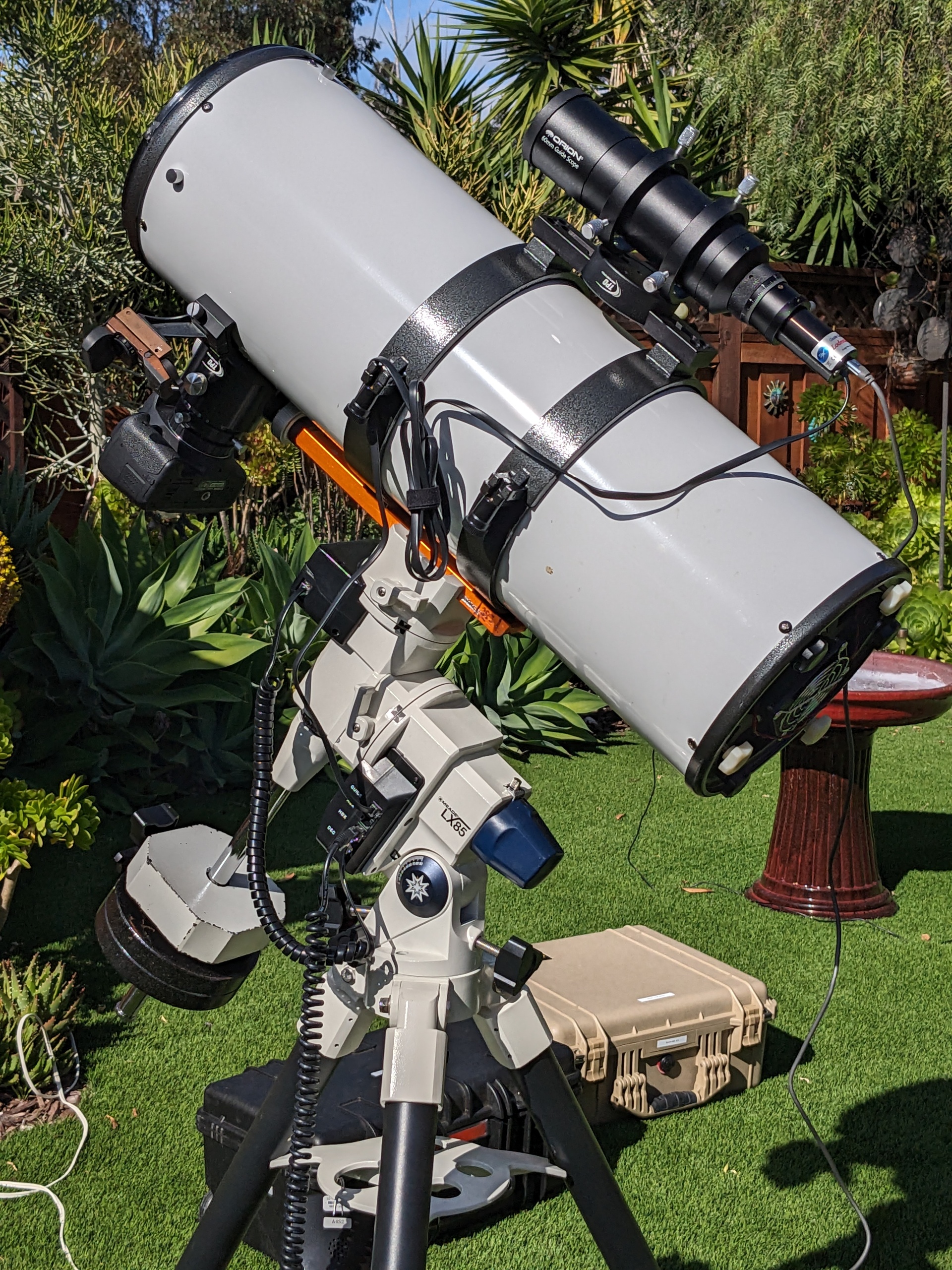 | SDAA-032: Advanced A complete deep sky astrophotography kit including the following: – Meade LX85 German Equatorial Mount with polar scope and Audiostar GOTO – Orion 8″ f/4 astrograph with 2″ focuser with 10:1 fine focus. Also includes a Bahtinov mask. – 50mm guide scope with helical focuser, and a Lodestar X2 guide camera – Canon EOS Rebel T3i DSLR with USB cable and digital intervalometer This kit is for SDAA members who are already familiar with deep sky astrophotography technique, and how to properly use a German Equatorial Mount. You will advance your skills by learning to set up and balance a complex astrophotography rig, and to use a guide scope for autoguiding your long exposures. The included DSLR will introduce you to prime focus astrophotography, if you have been using a cell phone camera or point-and-shoot up to this point. |
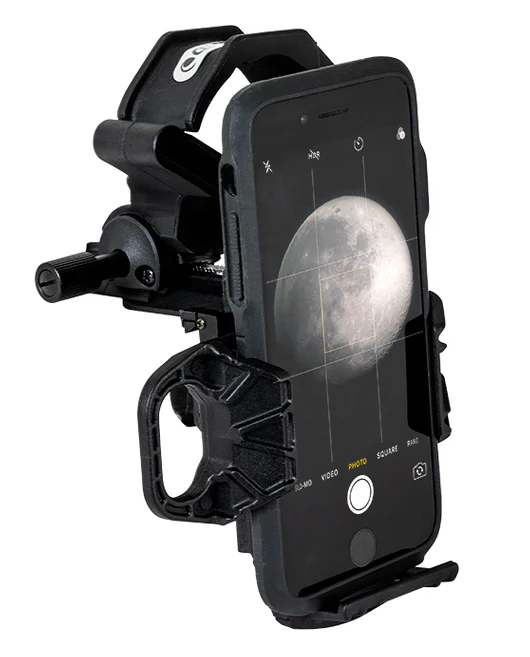 | SDAA-053: Beginner Celestron NexYZ 3-Axis Universal Smartphone Adapter Use this adapter to attach your smartphone to the eyepiece of your telescope and take photos. Smartphone cameras can take amazing photos these days with surprisingly short exposures. The challenge is trying to position the tiny camera lens over the tiny exit pupil of your telescope. This adapter makes that process easy, by providing fine adjustments in three axes so that you can position your smartphone camera just right and hold it there while you set up your shot. See Celestron’s product page for more details. |
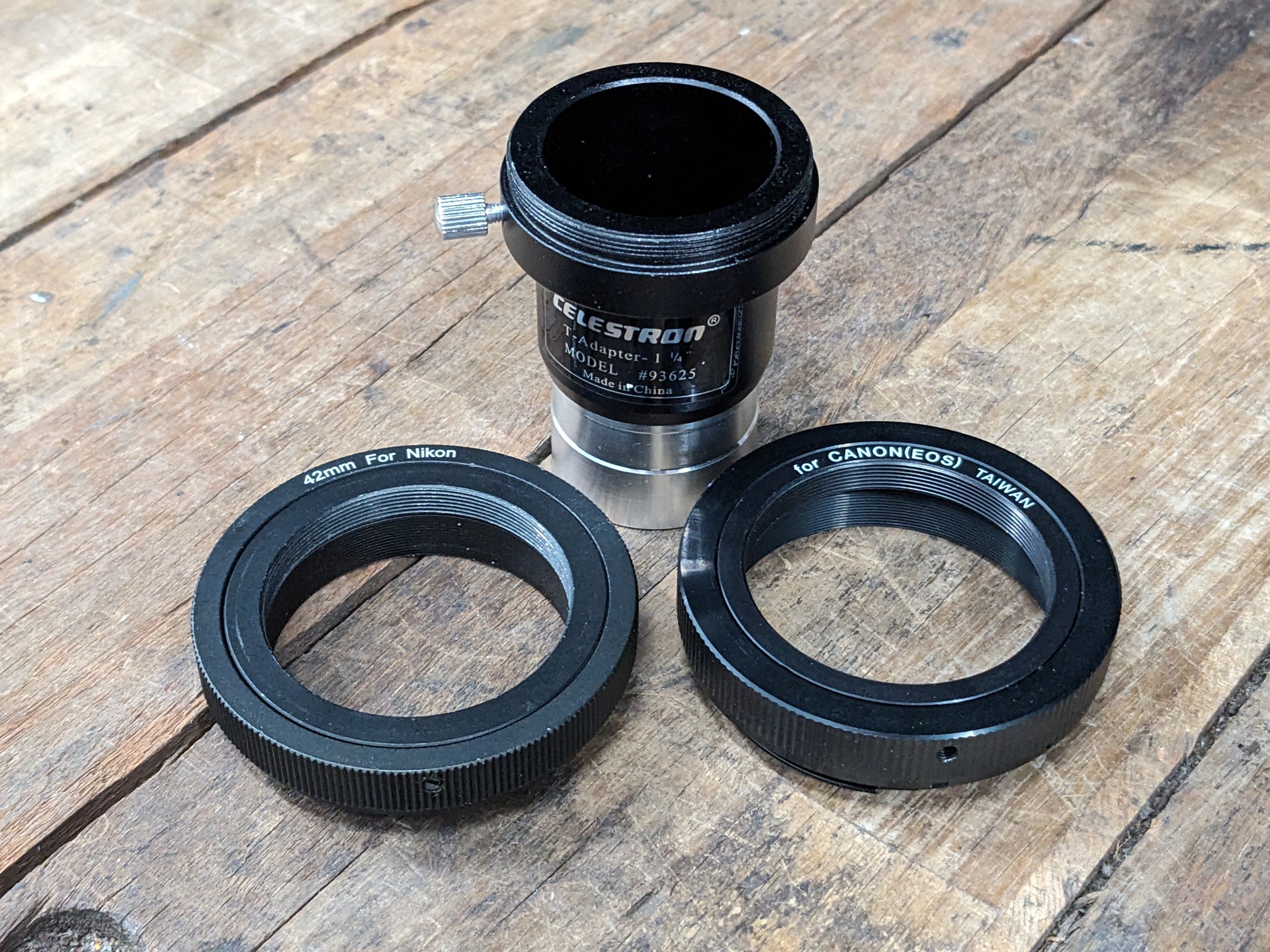 | SDAA-068: Beginner Canon EOS / Nikon F T rings These T adapters allow you to attach your Canon (EOS) or Nikon (F) DSLR to a telescope. The included 1.25″ T thread adapter will fit virtually any focuser. Note that you need a lot of back focus to use a DSLR with a T ring with a telescope. Most Newtonian scopes (unless specifically marketed as an “astrograph”) will not be able to reach focus. Refractors and SCTs should be fine. |
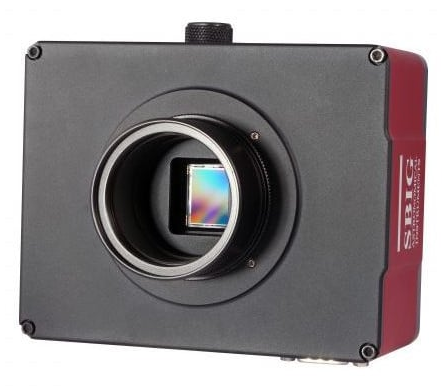 | SDAA-040: Advanced Santa Barbara Imaging Group (SBIG) STF-8300C cooled one-shot-color CCD camera The STF-8300C (color) camera is based on Kodak’s KAF-8300, 8.3 megapixel (3326×2504), full frame CCD. The KAF-8300 CCD is approximately 18 x 14mm (1.5″, smaller than APS-C but bigger than micro 4/3) and has a diagonal measurement of about 22 millimeters. With its relatively small pixels (5.4µm x 5.4µm) and large image area it is ideal for wide field imaging with short fast telescopes and camera lenses and at the same time is flexible enough to be used on long focal length Schmidt-Cassegrains. This is an older camera, but is fully ASCOM compliant and can still be controlled with modern astrophotography software through ASCOM. A guide for mounting the camera, setting up drivers, and configuring the camera with NINA is provided by the SDAA loaner program. Comes with a 2″ nosepiece, 2.5x 2″ barlow, 12v power supply, USB cable, and a hard-shell carrying case. |
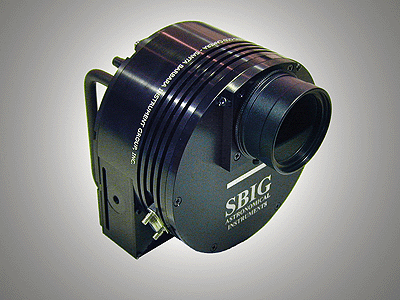 | SDAA-050: Advanced Santa Barbara Imaging Group (SBIG) ST-10XME cooled, self-guiding mono CCD camera with ten-position filter wheel The Model ST-10XME is the flagship of the “ST” series of self-guiding CCD cameras from SBIG. Like other self-guiding cameras in the ST series, the ST-10XME contains two CCDs. The imaging CCD is an enhanced KAF-3200ME imaging detector from Kodak with 3.2 million pixels, 2184×1472 resolution on a sensor measuring 14.9×10 mm. This is close to the 1″ sensor format. The camera includes a built-in TC-237H tracking CCD, eliminating the need for an off-axis guider pick-off mirror, or a secondary guide scope+camera. An external port allows for attachment of the SDAA-052 external guiding camera (which uses the exact same TC-237H CCD) if you prefer to guide using an external telescope. The Kodak KAF-3200ME CCD has amazing quantum efficiency of as high as 90% across the 550-700nm portion of the visible spectrum. It has ultra-low dark current of less than 1e-/pixel/second at 0 degrees C (typical) that allows moderate cooling for applications involving extended exposures. The high sensitivity of this sensor makes this camera ideally suited for shooting through narrowband filters. This is an older camera, but is fully ASCOM compliant and can still be controlled with modern astrophotography software through ASCOM. A guide for mounting the camera, setting up drivers, and configuring the camera with NINA is provided by the SDAA loaner program. Comes with 1.25″, 2″, and SCT thread nosepieces, power supply, 20 foot USB cable, desiccant packets, and a 10-position filter wheel containing Astrodon L, R, G, B, Ha, and OIII narrowband filters. Also includes a special Green Continuum filter with a 10nm bandpass around 510nm, used for scientific applications such as photometry. |
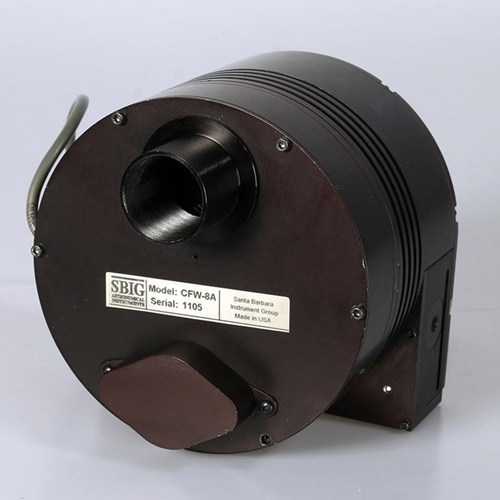 | SDAA-051: Advanced Santa Barbara Imaging Group (SBIG) ST-2000XM cooled, self-guiding mono CCD camera with five-position filter wheel This is a mono camera using the KAI-2020M CCD. The sensor measures 11.8mm x 8.9mm and has 7.4um square pixels. The sensor has a resolution of 1600 x 1200 pixels (2 megapixels). The sensor can read out at 16 bit depth and has a quantum efficiency of around 50%. The camera includes a built-in TC-237H tracking CCD, eliminating the need for an off-axis guider pick-off mirror, or a secondary guide scope+camera. An external port allows for attachment of the SDAA-052 external guiding camera (which uses the exact same TC-237H CCD) if you prefer to guide using an external telescope. This is an older camera, but is fully ASCOM compliant and can still be controlled with modern astrophotography software through ASCOM. A guide for mounting the camera, setting up drivers, and configuring the camera with NINA is provided by the SDAA loaner program. Comes with 1.25″ and 2″ nosepieces, power supply, 20 foot USB cable, desiccant packets, and a 5-position filter wheel containing Astrodon L, R, G, B filters. |
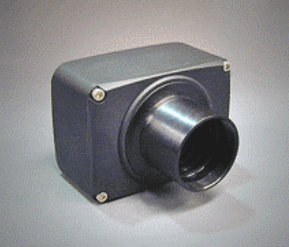 | SDAA-052: Advanced Santa Barbara Imaging Group (SBIG) CCDH-1 Remote Guide Head The Remote Guide Head is an optional accessory for ST series cameras that allows the convenience of self-guiding with the guider external to the camera and filter wheel if necessary. The same Remote Guide Head will work with ST model camera equipped with a Remote Guide Head port (SDAA-050 and SDAA-051). The Remote Guide Head contains a cooled TC-237H guiding CCD with 657 x 495 pixels at 7.4 microns and uses a 16-bit A/D. This is the same guiding CCD that is built into SDAA-050 and SDAA-051. It draws power from the main camera and is controlled by the same software that controls the internal guider. When the Remote Guide head is attached to the camera, you can use your camera control software to select either the built-in (“internal”) tracking CCD or the Remote Head (“external”) CCD for self-guiding during long exposures. It has its own shutter for dark frames. This camera is only usable as an accessory to SDAA-050 and SDAA-051, it cannot be used independently. |
 | SDAA-064: Intermediate Astronomik EOS APS-C Clip-in Filters Three Astronomik filters mounted in a clip-in adapter for Canon EOS APS-C DSLR camera bodies. The filter clips in just in front of the mirror, behind the lens bayonet. See the Astronomik product page for details. Includes three filters: SII-CCD (sulphur II), CLS (broadband light pollution), and UHC (combined OIII and H-beta). |
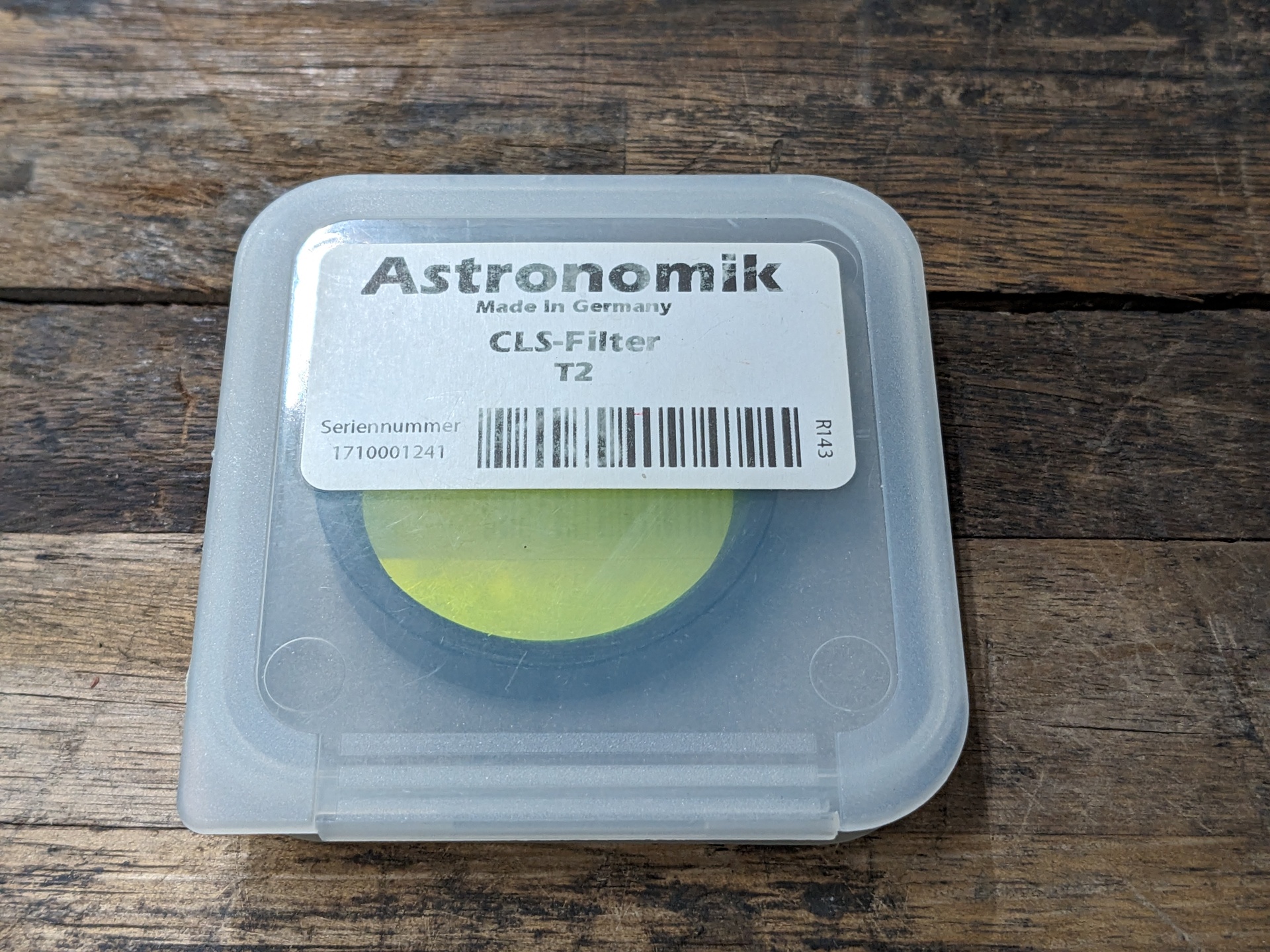 | SDAA-069: Intermediate Astronomik T2 thread CLS filter This is Astronomik’s CLS broadband light pollution filter, which cuts the light emitted by mercury vapor and both high and low pressure sodium lamps. This filter has T2 threads, and thus is meant to thread onto your camera’s T adapter inline with your imaging train. It will NOT thread onto a 2″ eyepiece. |
Eyepiece Kits
Premium eyepiece kits are available for members to loan, for use either with their own telescopes or with loaner telescopes. Try out different focal lengths and optical designs before you buy them for yourself!
 | SDAA-044 Astro-Tech Hyperwide (100°) and Ultrawide (82°) kit (best with <= f/5 scopes) Astro-Tech XWA and UWA eyepieces have high contrast, comfortable eye relief, and full field sharpness – with well-controlled astigmatism, field curvature, and lateral color. All eyepieces include soft rolldown eyecups to shield your eye from ambient light and improve the image contrast. The XWA (100°) eyepieces are favorably compared with Televue Ethos, and the UWA (82°) are favorably compared with Televue Nagler. If you have been wanting to try out the immersive, “spacewalk” effect of hyperwide eyepieces on your f/4-f/5 scope, this set will certainly impress. Kit includes: – 20mm XWA (100°) 2″ – 13mm XWA (100°) 2″ or 1.25″ – 7mm UWA (82°) 1.25″ – 4mm UWA (82°) 1.25″ – Weatherproof case |
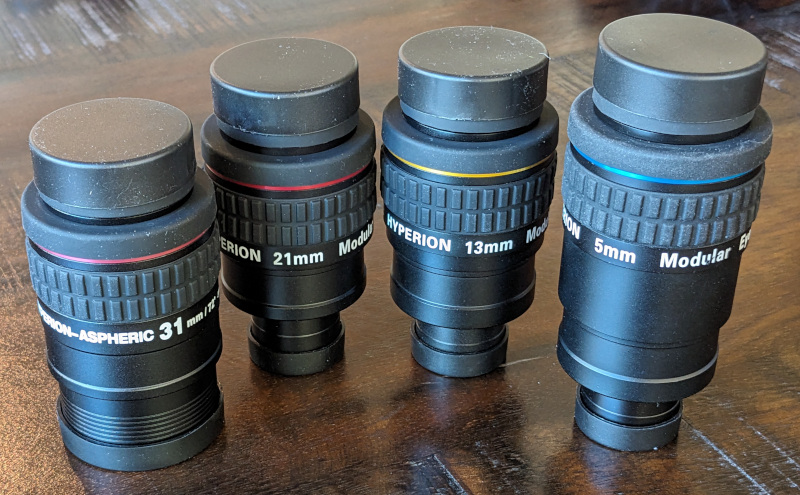 | SDAA-045 Baader Hyperion Superwide (72° and 68°) kit (best with >= f/5 scopes) The Baader Hyperion series of eyepieces are renowned among amateur astronomers for their exceptional versatility and performance. These eyepieces are designed with a wide 68-degree apparent field of view, providing an immersive experience that makes celestial observations feel expansive and detailed. Their high-quality optical construction, including multi-coated lenses, delivers sharp, high-contrast images with minimal chromatic aberration, making them ideal for both planetary and deep-sky viewing. Furthermore, their comfortable eye relief and compatibility with both 1.25-inch and 2-inch focusers make them a popular choice for those looking to enhance their stargazing sessions with superior clarity and ease of use. Kit includes: – 31mm Hyperion Aspheric (72°) 2″ – 21mm Hyperion (68°) 1.25″ – 13mm Hyperion (68°) 1.25″ – 5mm Hyperion (68°) 1.25″ – Weatherproof case |
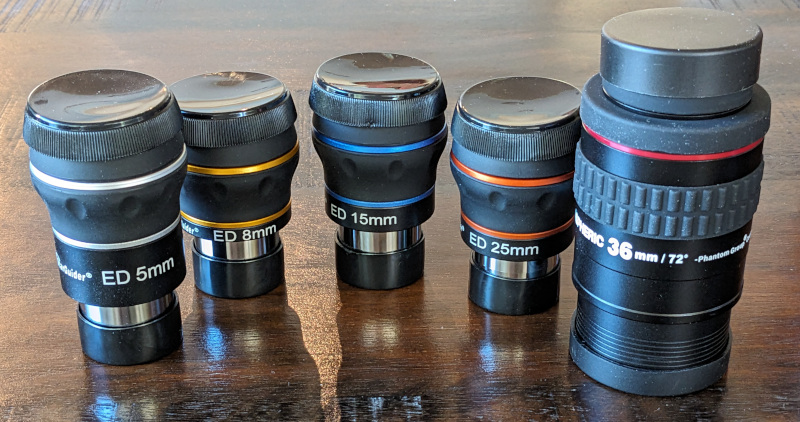 | SDAA-046 Agena Starguider Dual ED (60°) kit (best with >= f/6 scopes) With a true flat field and two high quality ED glass elements of different glass types, the Agena StarGuider Dual ED eyepieces (also known as the Astro-Tech Paradigm) are characterized by a significantly high contrast image. These 1.25″ fully multicoated (FMC) eyepieces give maximum detail and definition across the entire 60° field of view (FOV). Kit includes: – 36mm Baader Hyperion Aspheric (72°) 2″ – 25mm Agena Starguider Dual ED (60°) 1.25″ – 15mm Agena Starguider Dual ED (60°) 1.25″ – 8mm Agena Starguider Dual ED (60°) 1.25″ – 5mm Agena Starguider Dual ED (60°) 1.25″ – Weatherproof case |
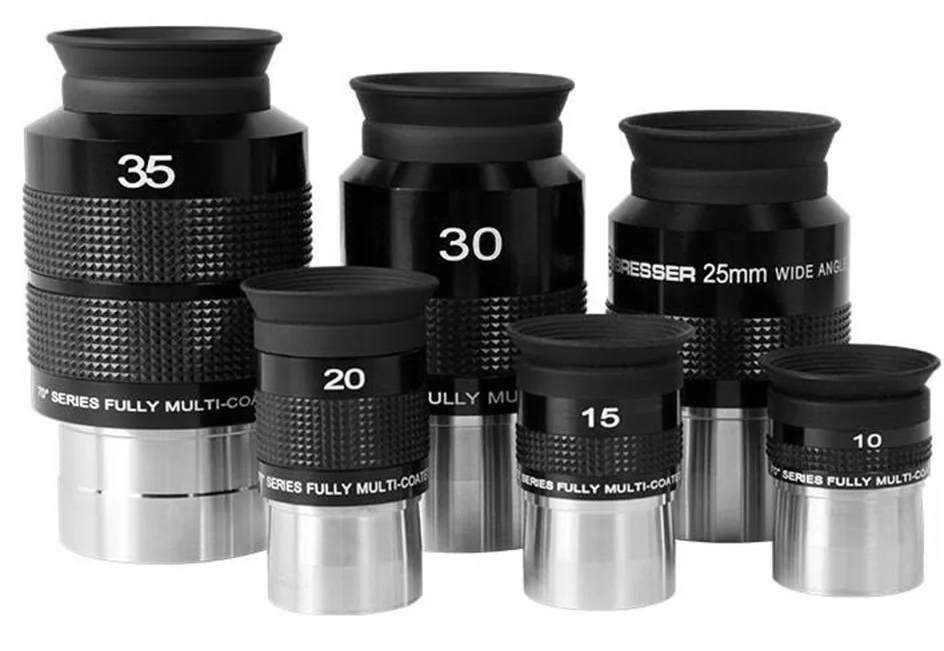 | SDAA-047 Explore Scientific / Bresser 70° Series kit (best with >= f/6 scopes) This eyepiece design, available generically as the GSO SuperView, represents a major advance compared to the original Plössl and Super-Plössl design. The five element design features tack sharp optical performance which delivers a improvement in corrections for chromatic aberration and edge-sharpness compared to traditional Plössl. The observing comfort is also much better with this eyepieces than with the conventional Plössl design. A good choice for telescopes with relaxed focal ratios. Kit includes: – 35mm Bresser 70° 2″ – 30mm Bresser 70° 2″ – 25mm Bresser 70° 2″ – 20mm Bresser 70° 1.25″ – 15mm Bresser 70° 1.25″ – 10mm Bresser 70° 1.25″ – Padded case and bolt cases |
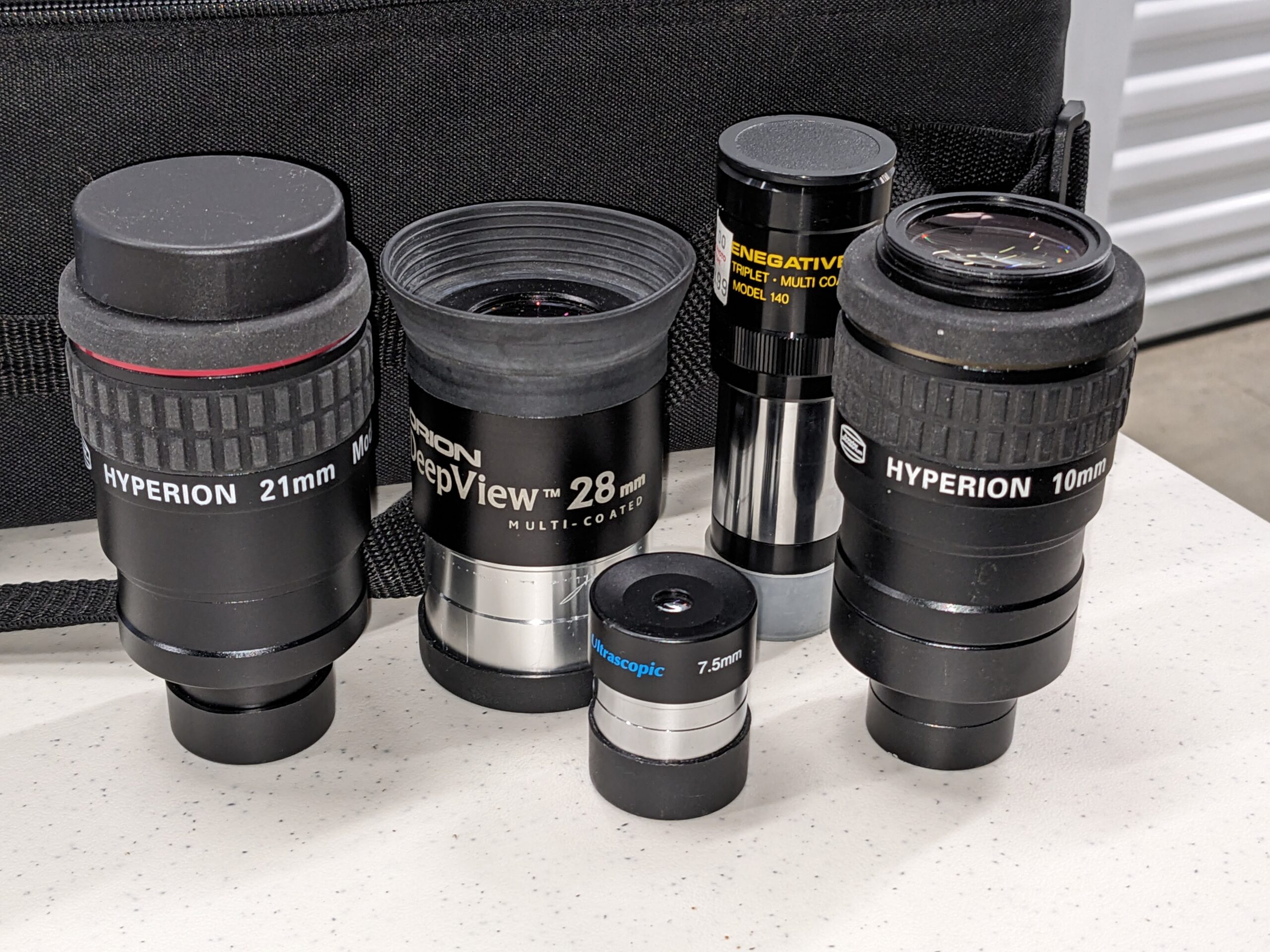 | SDAA-054 Premium Mixed Eyepiece kit (best with <= f/5 scopes) Includes: – 28mm Orion DeepView (2″) – 21mm Baader Hyperion 68° (1.25″/2″) – 10mm Baader Hyperion 68° (1.25″/2″) – 7.5mm Orion Ultrascopic – 2x apochromatic triplet barlow – case |
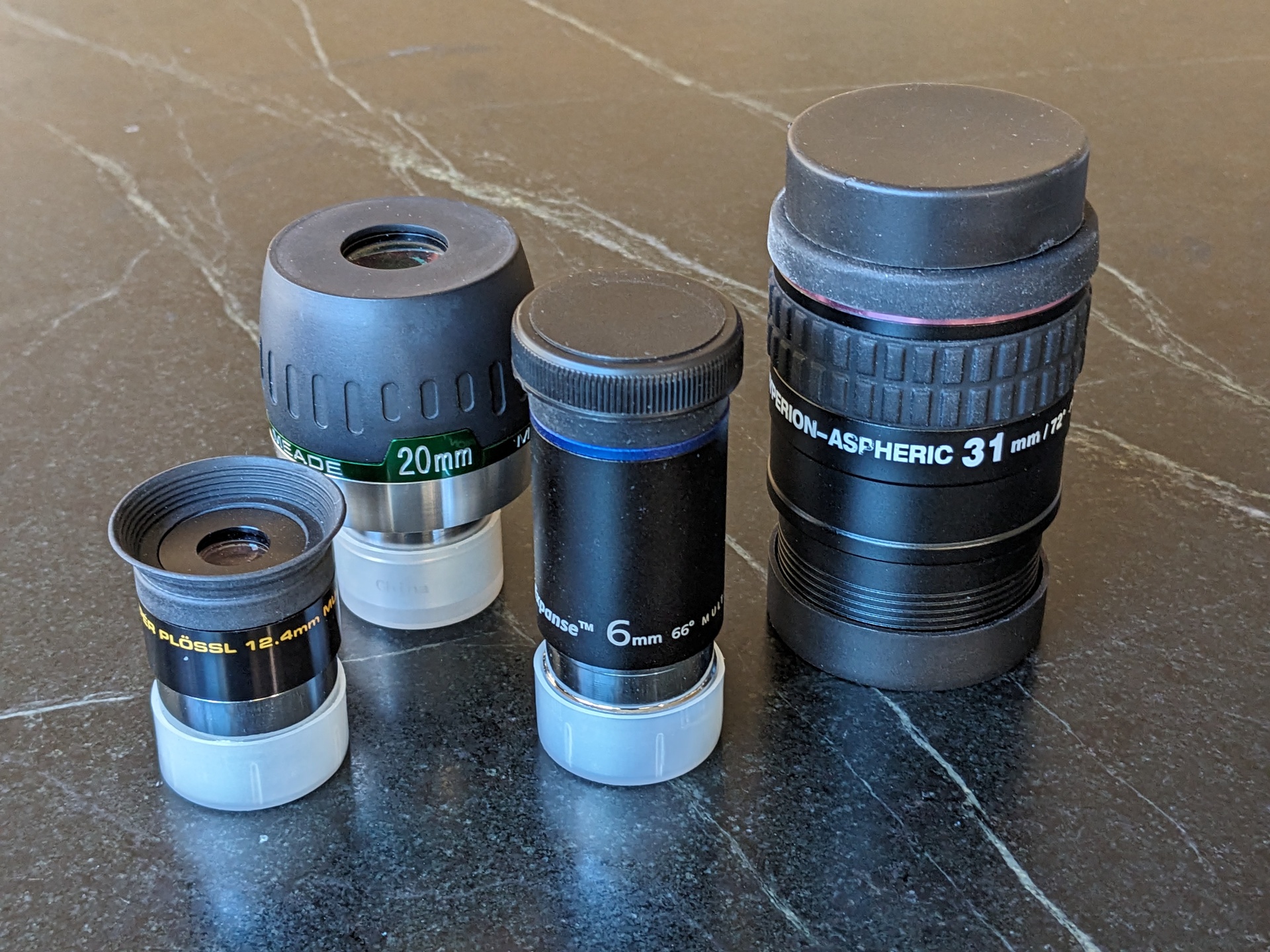 | SDAA-055 Premium Mixed Eyepiece kit (best with f/6 scopes) Includes: – 31mm Baader Hyperion Aspheric 72° (2″) – 20mm Meade SWA 82° – 12.4 Meade Series 4000 Super Plossl – 6mm Orion Expanse – case |
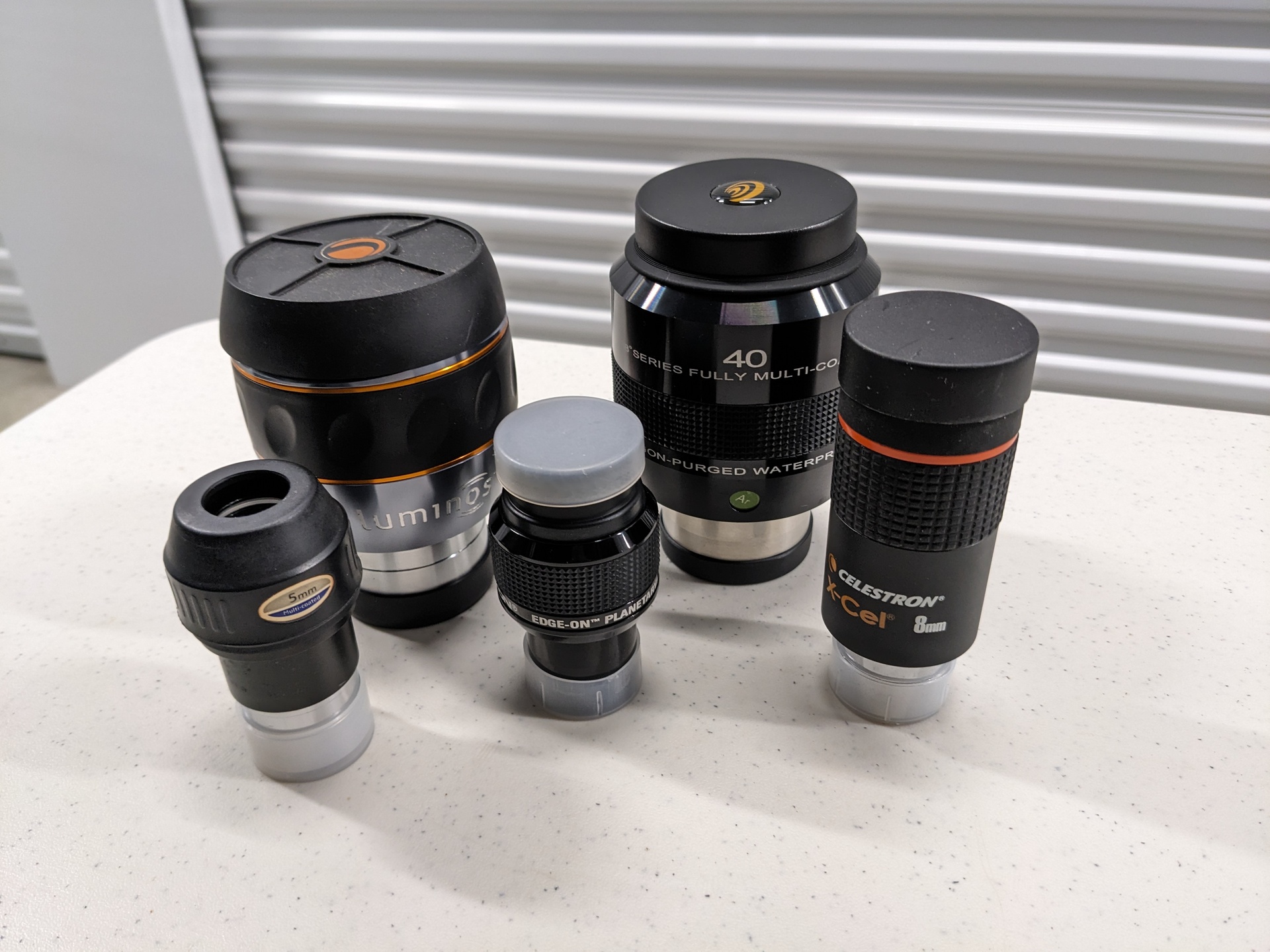 | SDAA-056 Premium Mixed Eyepiece kit (ideal for SCTs) Includes: – 40mm Explore Scientific 68° Series – 23mm Celestron Luminos (2″) – 14.5mm Orion Edge-on Planetary – 8mm Celestron XCel – 5mm Starguider clone – case |
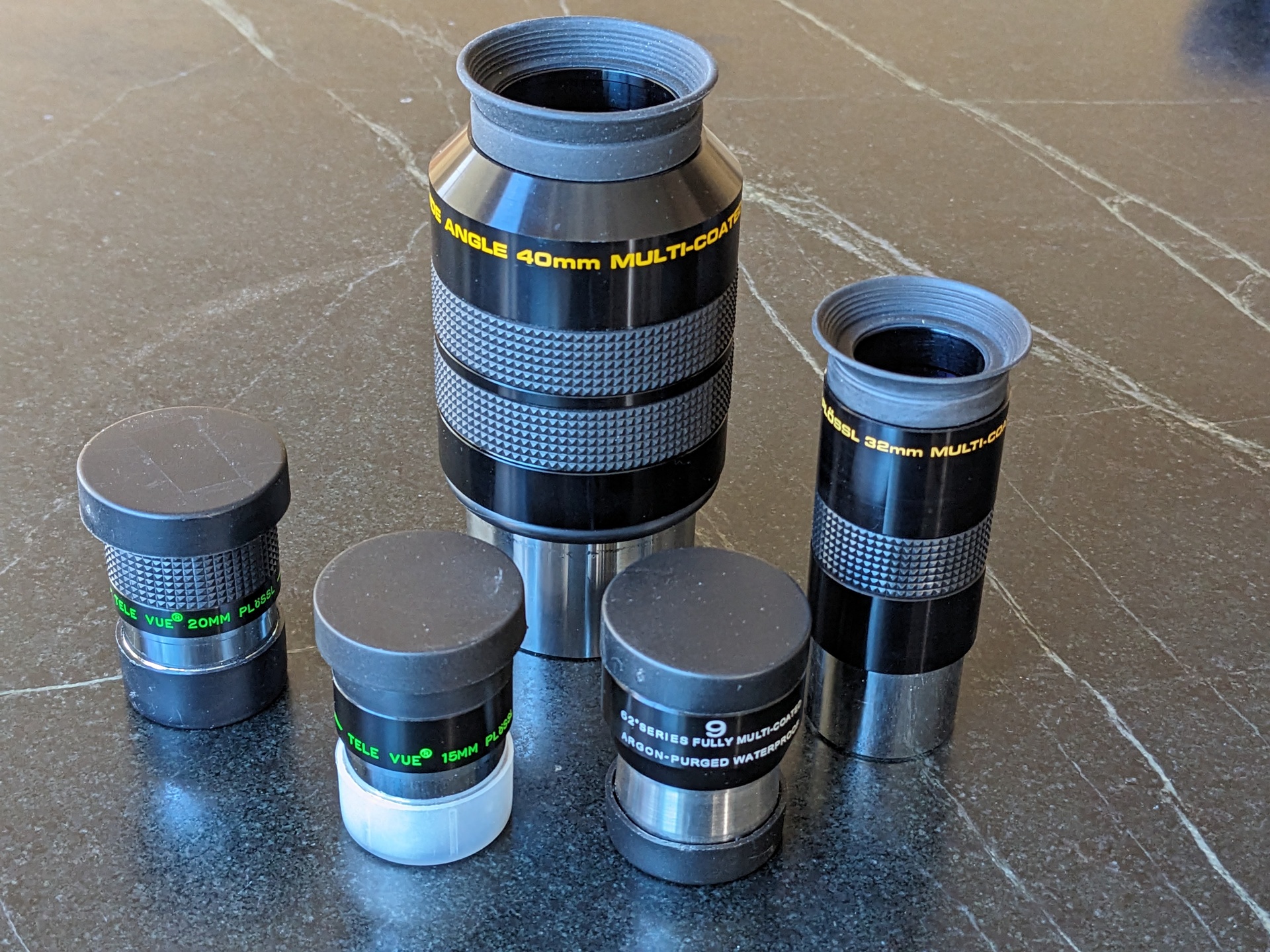 | SDAA-057 Premium Plossl Eyepiece kit (ideal for SCTs) Includes: – 40mm Meade Series 4000 Plossl (2″) for maximum field of view – 32mm Meade Series 4000 Super Plossl – 27mm Televue Panoptic – 20mm Televue Plossl – 15mm Televue Plossl – 9mm Explore Scientific 62° Series – case |
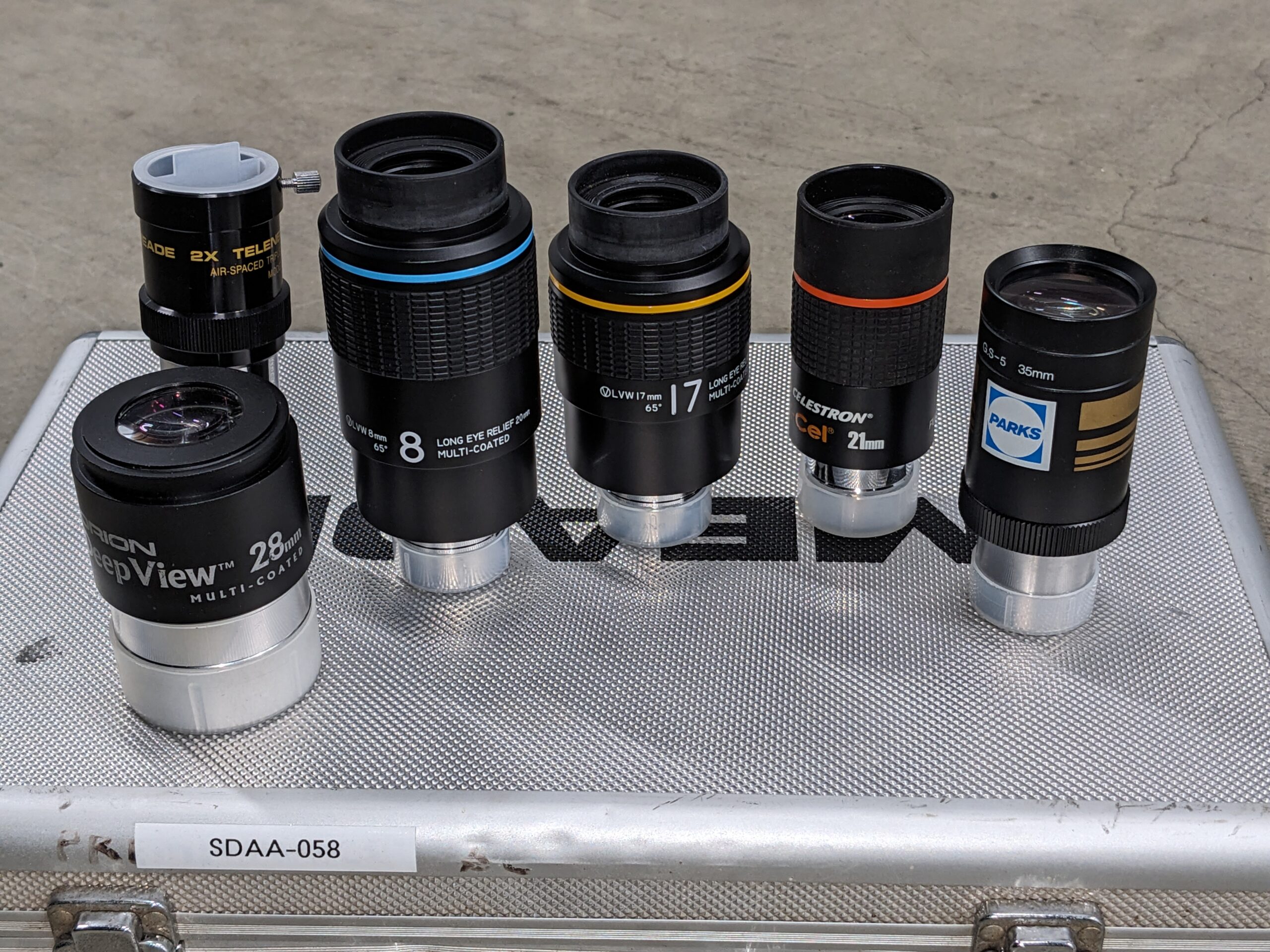 | SDAA-058 Mixed Premium Eyepiece kit (best with >= f/6 scopes) Includes: – 35mm Parks Gold Series – 28mm Orion DeepView (2″) – 21mm Celestron XCel – 17mm Vixen LVW – 8mm Vixen LVW – case |
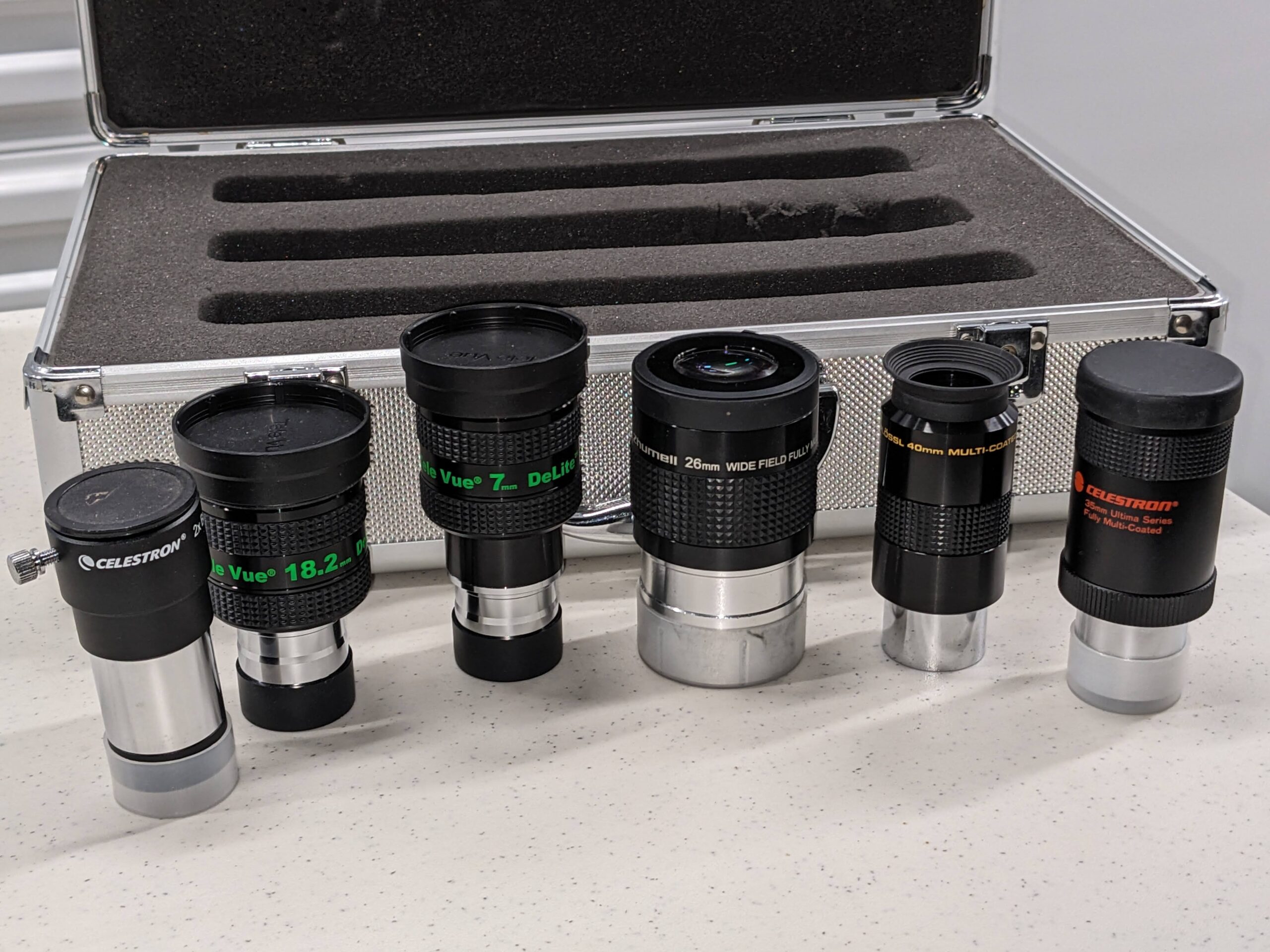 | SDAA-059 Premium Eyepiece kit (best with >= f/5 scopes) Includes: – 40mm Plossl – 35mm Celestron Ultima – 26mm Zhumell WA (2″) – 18.2mm Televue DeLite – 8mm Televue DeLite – 2x Barlow – case |
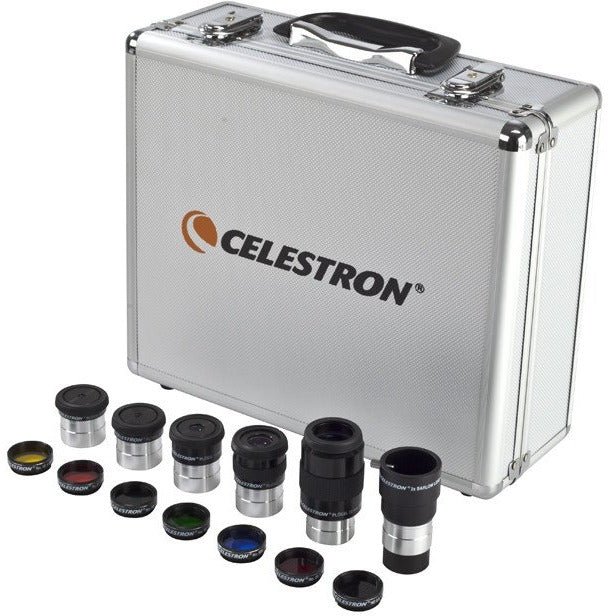 | SDAA-048, SDAA-075, SDAA-073, SDAA-080 Generic Orion/Celestron Plossl Eyepiece kit (best with >= f/6 scopes) Celestron / Orion’s entry-level Plossl eyepiece set. Plossl eyepieces have a 50° apparent field of view and comfortable eye relief in longer focal lengths. These are the types of eyepieces typically included with a new telescope. Kits include: – 32mm Plossl – 17mm Plossl – 13mm Plossl – 8mm Plossl – 6mm Plossl – 2x Barlow – Color filters – Hardshell case |
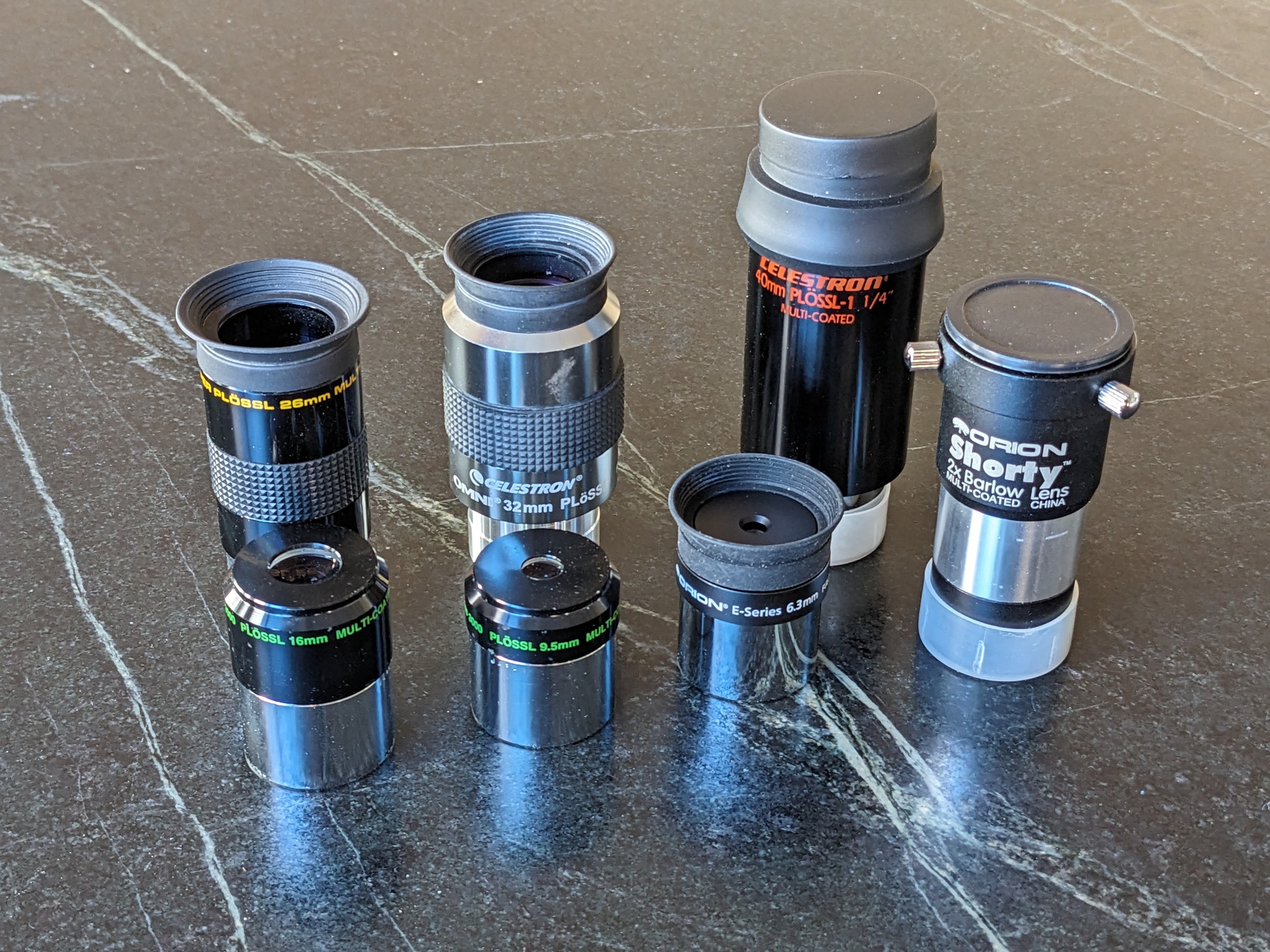 | SDAA-060, SDAA-061, SDAA-071, SDAA-072 Mixed Generic Plossl Eyepiece kit (best with >= f/6 scopes) Individual kits vary, but generally include: – 40mm Plossl – 32mm Plossl – 26mm Plossl – 16mm Plossl – 10mm Plossl – 2x barlow – case |
Miscellaneous Equipment
Some unusual or specialized equipment is also available to loan. For example, solar telescopes that are used during the day!
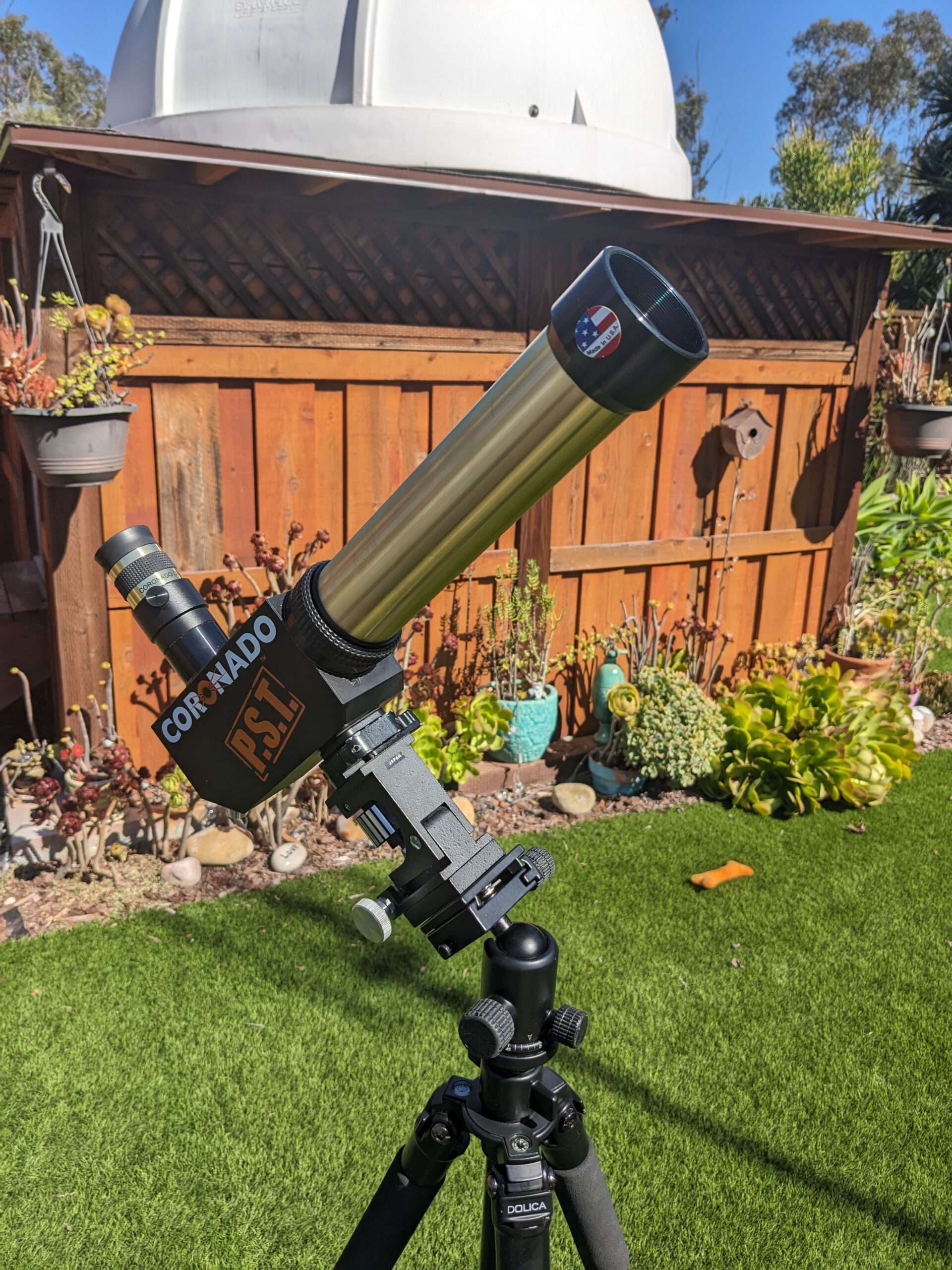 | SDAA-034, SDAA-037 Coronado Personal Solar Telescope (PST) Coronado’s iconic Personal Solar Telescope (or PST for short) is an incredibly portable way to view the sun in hydrogen-alpha light, capable of sitting on top of even modest photo tripods. The Sun’s got a lot going on, and the PST will show it to you. By zeroing in on the far end of the Sun’s visible light spectrum — the hydrogen-alpha line — the PST reveals our closest star rolling with violent, ever-changing activity. 40mm f/10 optics with a <1.0 Å bandpass etalon. Observe solar prominences and surface granulation impossible to see with a simple white-light solar filter. Note that these telescopes are not suitable for taking photos of the sun. They are visual instruments only. We have two of these telescopes available to loan. Both have Vixen-style dovetails, or may be mounted to a sturdy photo tripod. You might also consider borrowing SDAA-074 (below) to mount it. We also have an Orion AstroView mount (manual GEM) available if you wish to use a beefier mount. |
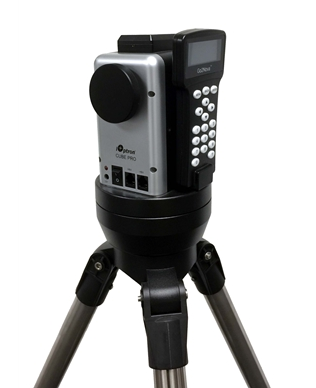 | SDAA-074 iOptron Cube Pro mount This tiny little 3 pound alt-az mount can carry an 8 pound payload on its side saddle. Perfect for lightweight telescopes like small 80mm refractors, or reflectors up to 114mm. The mount runs on 8x AA batteries and has full tracking and GOTO capability. Includes the mount, hand control, tripod, and a padded carrying case. |
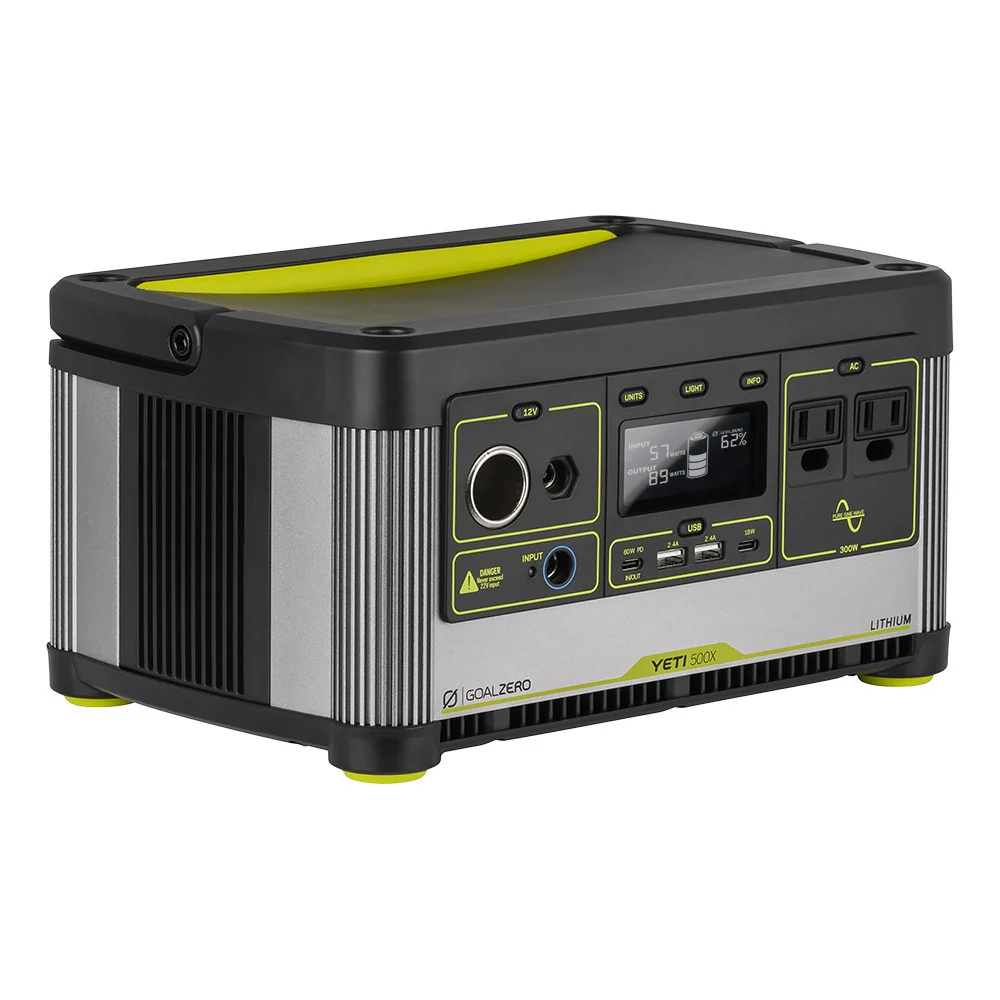 | SDAA-039 GoalZero Yeti 500x Power Station Portable power station with 12V, 60W USB-PD, and 300W 110V AC inverter. 500Wh Lithium battery. Includes soft carrying case. |
 | SDAA-081 Celestron Power Tank Portable 12V 7Ah power box with two 12V cigarette lighter power outlets as well as a bright floodlight and red spotlight. Includes a cigarette lighter to barrel jack cable for powering most telescope mounts, and a 15V AC adapter for charging the battery. |
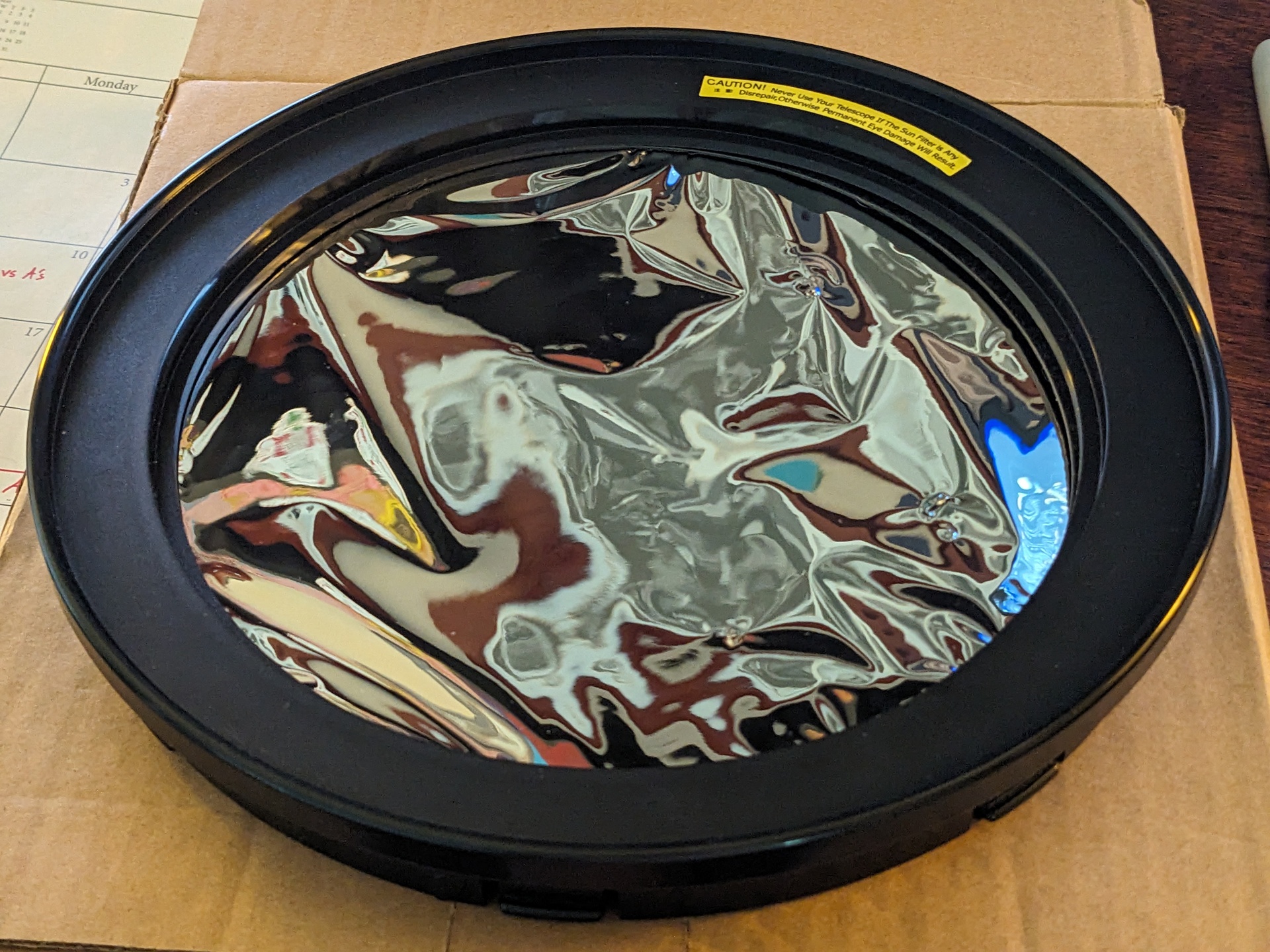 | SDAA-043 Baader Solar Filter for 8″ Dobsonian Telescopes This solar filter accessory clips onto the front of solid-tube 8″ Dobsonians like SDAA-026, SDAA-031 and SDAA-042. When in place, it allows you to observe the sun in full spectrum white light. Excellent for observing sunspots. If you want to see prominences and surface granulation, you need a Hydrogen Alpha telescope, such as SDAA-034 or SDAA-037. |
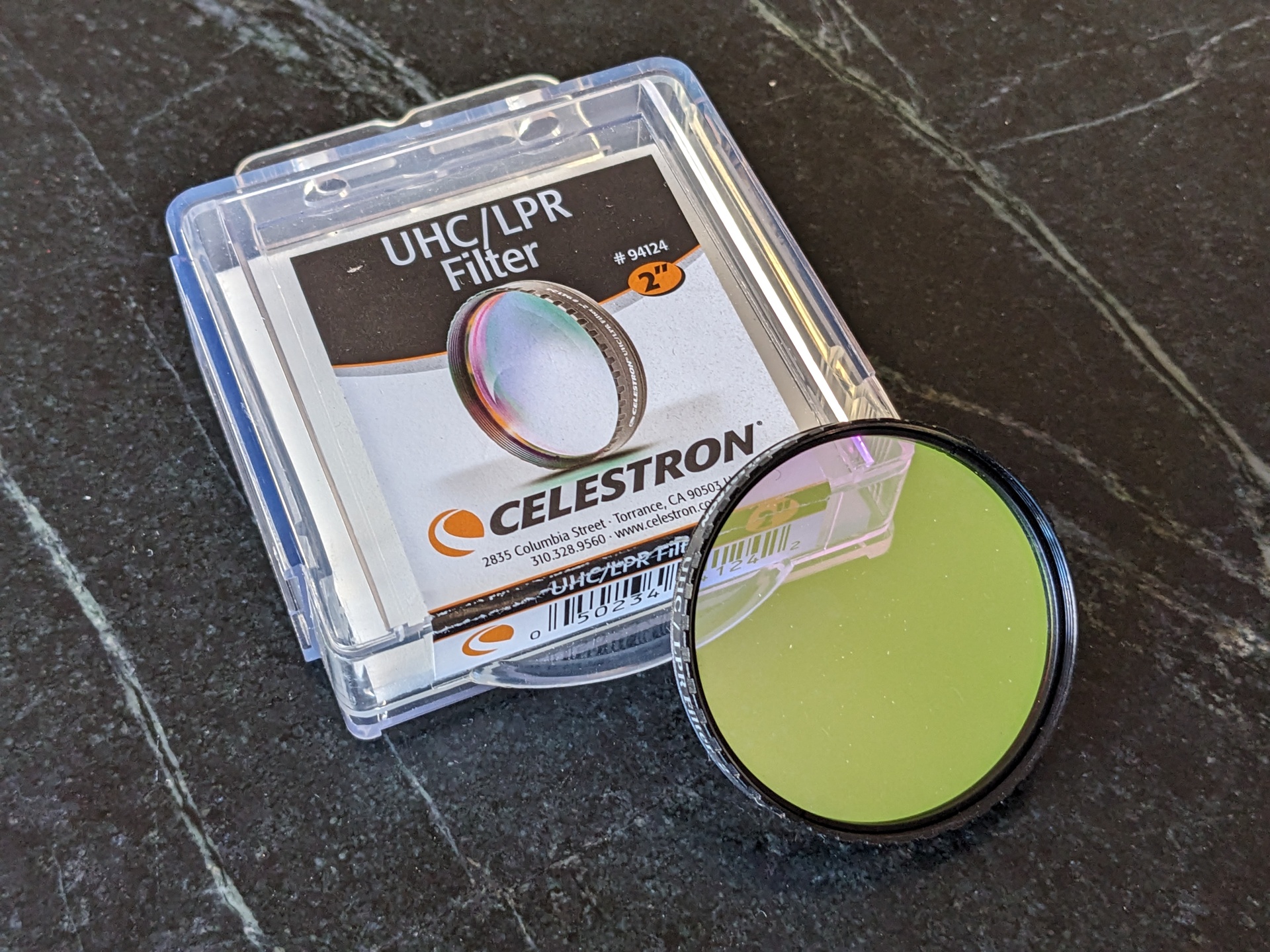 | SDAA-063 Celestron UHC/LPR filter (2″) This 2″ Light Pollution Reduction (LPR) Filter is designed to selectively reduce the transmission of certain wavelengths of light, specifically those produced by artificial light. This includes mercury vapor, and both high and low pressure sodium vapor lights and the unwanted natural light caused by neutral oxygen emission in our atmosphere (i.e. sky glow). This “UHC” LPR filter is still a broadband filter, but delivers higher contrast of emission nebulae than typical neodymium light pollution filters. The coatings enable the filter to achieve a high transmission of over 97% across the entire bandpass, with total blockage of prominent light pollution lines. This filter can help improve visibility of nebulae and galaxies from light polluted suburban skies. However, no filter is as good as driving out to a dark site. |
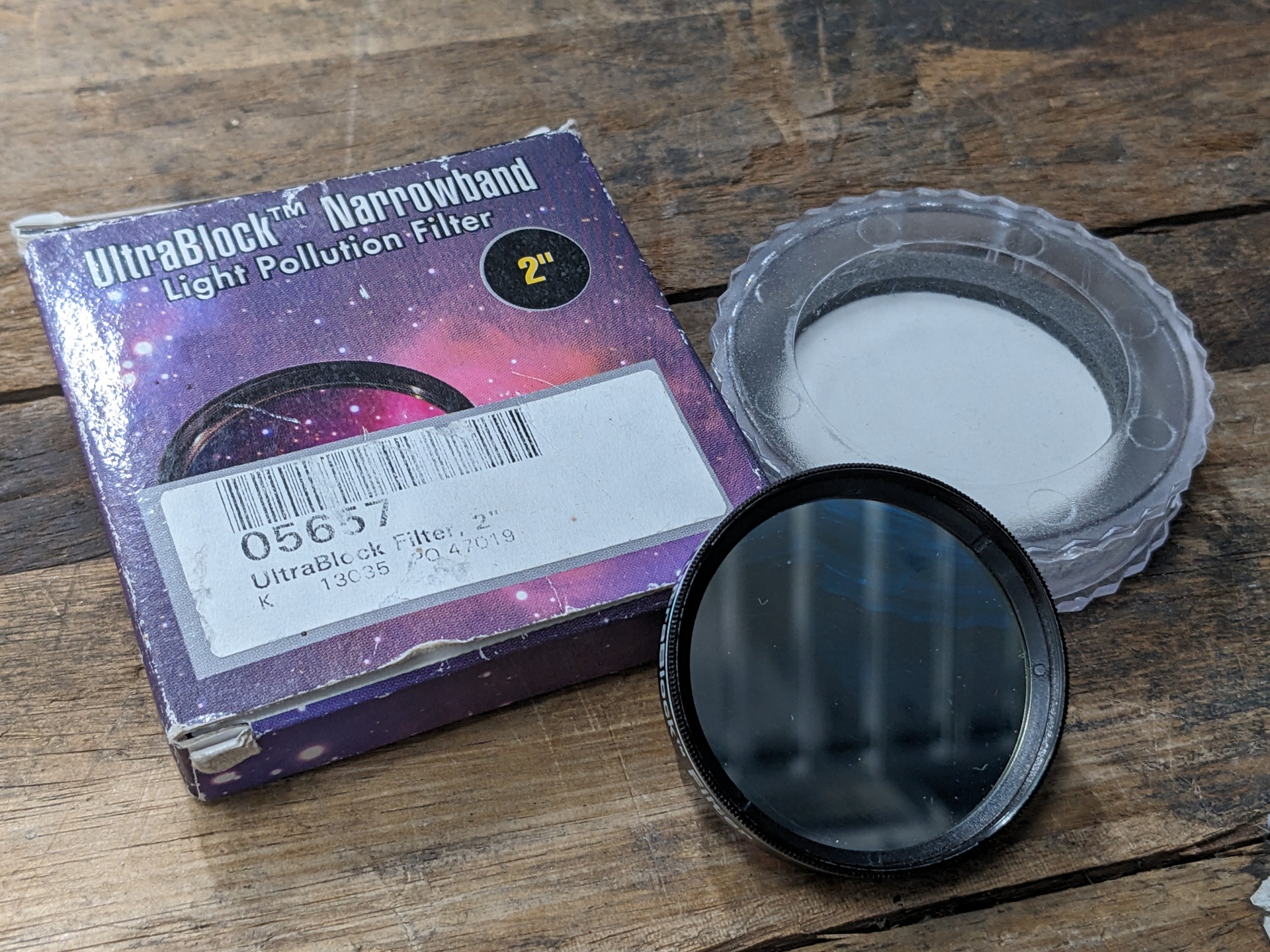 | SDAA-070 Orion UltraBlock UHC filter (2″) The Orion UltraBlock filter is a narrowband filter designed to enhance the visibility of deep-sky objects, particularly in light-polluted skies. By blocking most artificial light wavelengths and isolating key emission lines, such as those from hydrogen-beta and oxygen-III, it improves contrast on nebulae and other faint celestial targets. This filter is ideal for urban astronomers and enhances views of objects like the Orion Nebula and the Lagoon Nebula. It is compatible with both visual observing and imaging setups. |
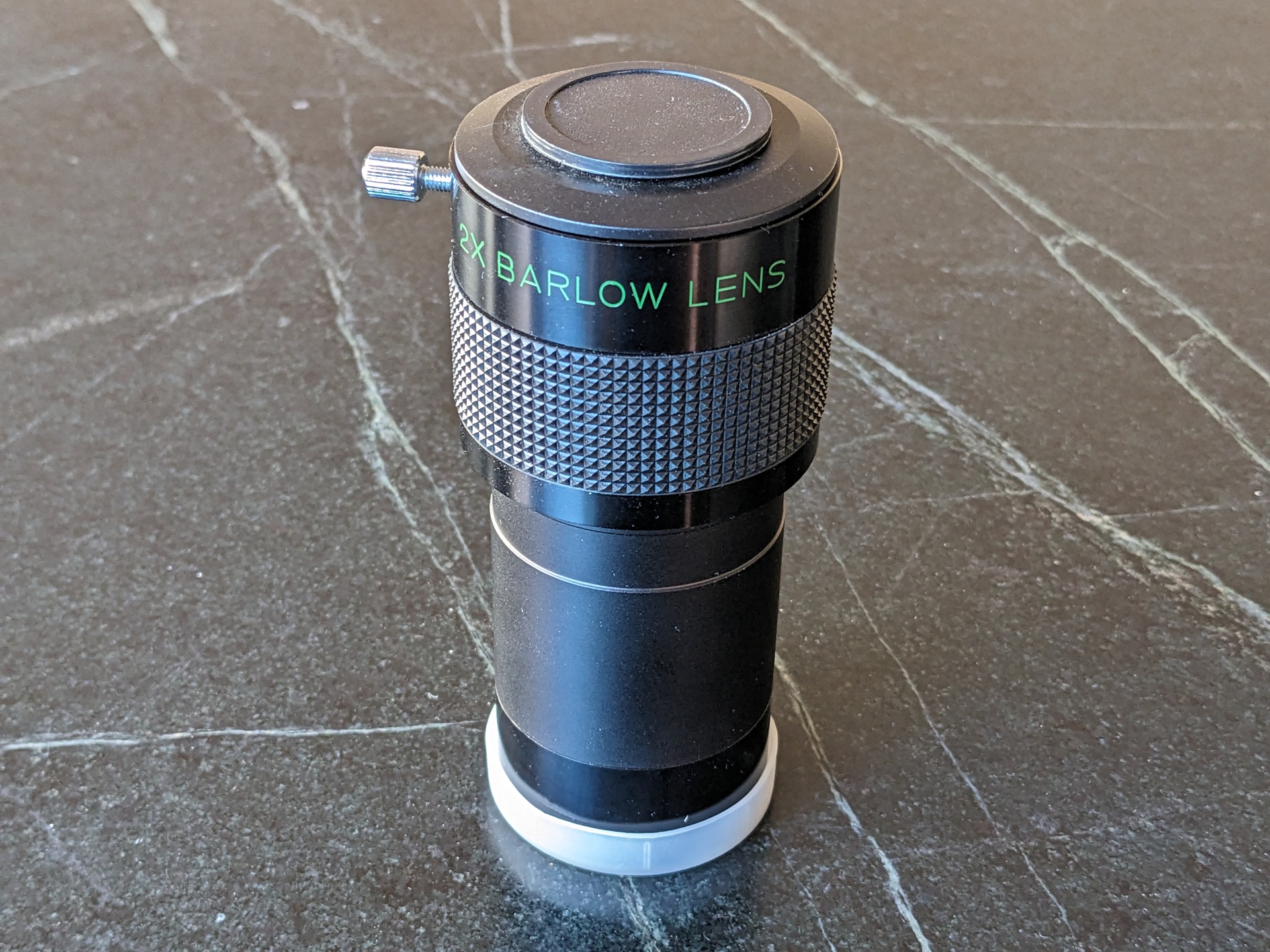 | SDAA-062 2″ 2x Barlow Borrow this big 2x barlow to double the magnification from your 2″ eyepieces or cameras with 2″ nosepieces. Comes with a 1.25″ adapter. |
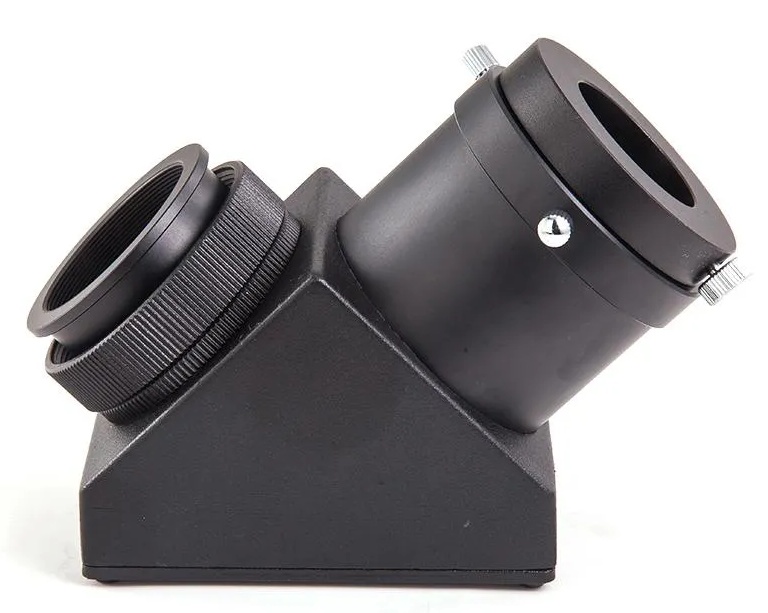 | SDAA-079 2″ Mirror Diagonal This Celestron mirror diagonal includes both a standard 2″ barrel nosepiece as well as a threaded SCT nosepiece, so you can try out both styles. Also includes a 2″ SCT visual back. Try out some wide field 2″ eyepieces in your SCT or refractor. Includes 1.25″ adapter. |
 | SDAA-065, SDAA-066, SDAA-067 Laser Collimation Tool Brands and styles vary. Borrow one of these laser collimation tools to make aligning the mirrors on your Newtonian reflector easy. |
Current Inventory Status
The table below shows the current status of the SDAA loaner inventory. The due date is not a gurantee that the equipment will be returned by that date: scheduling conflicts and inclement weather can often push return dates out, so do not count on equipment being returned by the due date. It is always best to contact the SDAA Loaner Equipment Coordinator to express your interest in an item, and to get on the waitlist if it is already checked out.
